Advertisement
Supported by

Review: ‘Schubert’s Winter Journey’ Allows Ian Bostridge to Obsess
- Share full article

By Michael Cooper
- Feb. 18, 2015
When Schubert played “Winterreise,” one of the greatest cycles of art songs, or lieder, ever written, for a gathering of his friends, they were puzzled. As one member of his circle recalled decades later, they were “utterly dumbfounded by the mournful, gloomy tone of these songs.”
But the ailing Schubert, who corrected the proofs of “Winterreise” in the days before he died in 1828, at 31 (of what was probably complications from syphilis), had faith in the work, telling friends, “I like these songs more than all the rest, and you will come to like them as well.”
Many have come to like, and love, the songs in the years since, as the still-expanding catalog of recordings and steady stream of recitals around the world attest. But while initiates find its 24 songs of Romantic, angst-filled wandering cathartic, “Winterreise,” or “Winter Journey,” can leave others discomfited by the intensity of Schubert’s music and the poet Wilhelm Müller’s intriguing but oblique lyrics, which tell a largely plotless tale of heartbreak, alienation and cold, in its physical and metaphorical dimensions.
A new book promises to deepen the understanding of the legions of “Winterreise” devotees, while offering encouragement to interested music lovers who have had difficulty following the lieder. The tenor Ian Bostridge, a leading interpreter of “Winterreise,” has written a cross between an idiosyncratic guide to the song cycle and a freewheeling meditation on it, “Schubert’s Winter Journey: Anatomy of an Obsession,” which he says at the outset aims “to explain, to justify, to contextualize and embroider.”
Mr. Bostridge is perhaps uniquely suited to the task. Not only is he a singer who has performed the cycle more than a hundred times, made a celebrated recording of it and grappled with its intricacies for decades, but he is also a smooth writer who earned a doctorate from Oxford for his study of witchcraft in English public life in the 17th and 18th centuries.
His small, heavy book — the attractively illustrated hardcover is hardly bigger than a standard paperback, but weighs some two pounds because of the glossy paper it is printed on — is not a musical guide in any traditional sense, although there is a chapter dedicated to each song. No musical notation appears until Page 152, when it is used to illustrate a surprisingly interesting debate about how pianists should play a section of “Wasserflut” (or “Flood”). Rather, Mr. Bostridge, something of a polymath, draws on his deep reading and his long experience singing the cycle to explore Schubert’s world, the roots of the songs and how they have been received since they were written.
So, yes, there is plenty on the brooding Romantic world of Byron and Goethe, and Mr. Bostridge gives the overview of the debate on whether Schubert was homosexual or heterosexual. (His short answer: We don’t really know, and modern conceptions of sexuality are not a terribly useful prism to try to view him through.) But there are also many unexpected, often delightful asides.
An exploration of the song “Gefrorne Tränen,” or “Frozen Tears,” notes that “the tears shed in emotion contain 20 to 25 percent more protein than those produced when chopping onions.” A discussion of the ice crystal flowers that form on windowpanes, in the context of the song “Frühlingstraum” (“Dream of Spring”), includes a sampling of a few of the 5,000-odd photographs of snowflakes taken by Wilson Bentley, an American who, Mr. Bostridge tells us, “died in 1931 after walking six miles home in a blizzard.”
The broadness of Mr. Bostridge’s palate is evident in his chapter on one of the most famous songs in the cycle, “Der Lindenbaum” (“The Linden Tree”). He looks at how poets including Homer and Ovid have written of linden trees, and about the debate over whether Romanticism’s obsession with death — which many listeners hear in the song — paved the way for the European catastrophes of the 20th century. And he writes of the role Schubert’s song was to play later in contexts as varied as Thomas Mann’s “The Magic Mountain” and the German-language version of “The Simpsons,” in which he notes that “a version of the song is rapped by Bart.”
At times, Mr. Bostridge risks over-egging the pudding. When the song’s narrator takes refuge in an empty charcoal burner’s hut in the song “Rast” (“Rest”), Mr. Bostridge goes into a detailed digression about charcoal, telling us the temperatures at which wood and charcoal burn and reproducing a chart showing the shift in power sources used in England from 1561 to 1859.
Far more illuminating is the remainder of the chapter, which describes the political and artistic repression in Metternich’s Austria that Schubert and his circle faced, and connects the absent charcoal burner to the revolutionary Italian Carbonari: “literally ‘charcoal burners,’ the secret society whose black and red were feared by the Hapsburg regime.”
Mr. Bostridge, who writes that he started as a singer learning by ear, takes special care in passages about music to make them understandable to readers who do not read music or are unfamiliar with its terminology. So he does not merely define “arpeggio,” but gives it a back story, writing that “the word arpeggio comes from the harp, and means a chord played in sequence rather than all at once.” And some of his keenest observations are almost dashed off, as when he notes that in much of Schubert “the major key is even more heartbreaking than the minor.”
What ultimately gives the book its authority is Mr. Bostridge’s experience singing the songs. He makes technical observations, to be sure, but also broader ones, as when he writes that “so much of what we have to do as ‘realizers’ of the score is not in the score, either in words or in notation; that gap is what makes ‘interpretation’ necessary.” He gives a sense of what it is like to be onstage: Most halls, he says, are lit well enough so people can refer to the text, and he can often recognize members of the audience and see their reactions, favorable and unfavorable. He wrestles, too, with what it means to sing songs that are embedded with social protest in “the red plush halls of the classical tradition.”
If, in the end, the mysteries still remain — Mr. Bostridge translates the cycle’s enigmatic opening lines as “I came a stranger, I depart a stranger” — readers will find that Mr. Bostridge has proved a thoughtful, often entertaining tour guide who has given them plenty to think about the next time they find themselves in a concert hall facing a singer and a pianist.
SCHUBERT’S WINTER JOURNEY
Anatomy of an obsession.
By Ian Bostridge
Illustrated. 502 pages. Alfred A. Knopf. $29.
Explore More in Books
Want to know about the best books to read and the latest news start here..
Salman Rushdie’s new memoir, “Knife,” addresses the attack that maimed him in 2022, and pays tribute to his wife who saw him through .
Recent books by Allen Bratton, Daniel Lefferts and Garrard Conley depict gay Christian characters not usually seen in queer literature.
What can fiction tell us about the apocalypse? The writer Ayana Mathis finds unexpected hope in novels of crisis by Ling Ma, Jenny Offill and Jesmyn Ward .
At 28, the poet Tayi Tibble has been hailed as the funny, fresh and immensely skilled voice of a generation in Māori writing .
Amid a surge in book bans, the most challenged books in the United States in 2023 continued to focus on the experiences of L.G.B.T.Q. people or explore themes of race.
Each week, top authors and critics join the Book Review’s podcast to talk about the latest news in the literary world. Listen here .
- Work & Careers
- Life & Arts
‘Schubert’s Winter Journey: Anatomy of an Obsession’, by Ian Bostridge
- ‘Schubert’s Winter Journey: Anatomy of an Obsession’, by Ian Bostridge on x (opens in a new window)
- ‘Schubert’s Winter Journey: Anatomy of an Obsession’, by Ian Bostridge on facebook (opens in a new window)
- ‘Schubert’s Winter Journey: Anatomy of an Obsession’, by Ian Bostridge on linkedin (opens in a new window)
- ‘Schubert’s Winter Journey: Anatomy of an Obsession’, by Ian Bostridge on whatsapp (opens in a new window)
Review by Hannah Nepil
Roula Khalaf, Editor of the FT, selects her favourite stories in this weekly newsletter.
Tears can be cathartic. They help us process extreme happiness or sadness. But a tearless response can be equally profound. Take Winterreise , the 1827 song cycle about a lovelorn wanderer’s desolate winter journey. It ranks as one of the bleakest, most moving statements of German Romanticism, thanks to the alchemy between Franz Schubert’s music and Wilhelm Müller’s poetry. Yet in almost 30 years of performing it, tenor Ian Bostridge has only seen one spectator cry. Something about the piece prompts us to internalise our emotions.
So Bostridge argues in Schubert’s Winter Journey: Anatomy of an Obsession , his new book about Winterreise . In the process he delivers a mini-lecture, explaining that the cult of sensibility and its encouragement of expressiveness — a product of the mid to late 18th century — had, by the 1820s, become the subject of mockery.
Such lateral thinking exemplifies Bostridge’s aim: to illuminate the enigmatic “Mount Everest” of song cycles with any fact or finding at his disposal. And he has gathered quite a few. History, literature, visual art, etymology and years of musical experience are brought to bear on his analysis of these 24 songs, each addressed in a separate chapter. What emerges with compelling force is the author’s intellectual curiosity and passion for his subject. He has, after all, been obsessed with German song — the Lied — since first encountering it as a schoolboy, and has performed Winterreise around 100 times.
As he points out, he does not have a musicological background, and this book is far from a technical guide to the work. Not that Bostridge lacks academic credentials: he has an Oxford doctorate on witchcraft in 17th- and 18th-century England, and in 2011 published A Singer’s Notebook , a collection of essays. In Schubert’s Winter Journey every chapter is crammed with original insights, generating a complex discussion.
Schubert’s protagonist is central to this. Is he an everyman, a Byronic figure deliberately shrouded in mystery? He might be an existentialist in a meaningless, indifferent world, someone akin to a character in a Samuel Beckett play. Perhaps he is a stranger in his own country, not unlike Schubert and Müller themselves. On this point Bostridge is particularly forthcoming, tirelessly decoding references in songs including “Gefrorne Tränen” to a post-Napoleonic Vienna “frozen” by Prince Metternich’s repressive regime.
Or perhaps the wanderer’s sense of alienation stems from another source. In 1815 a new Austrian law was passed preventing men of insufficient means from marrying. That may be why Schubert was unable to marry his neighbour Therese Grob, as he had hoped. Another love, for a woman of a much higher social status, similarly came to nothing. It’s not surprising, Bostridge concludes, that he eventually contracted syphilis, most likely in a “run-of-the-mill bordello”. And the impact of that fatal disease is vividly spelt out in the book, along with its array of humiliating treatments: “A hot room (up to 29 degrees centigrade) with no open windows. No change of underwear or bedding, no washing except rinsing the mouth . . . An unguent of lard and mercury was to be applied to various parts of the body every second day.” It’s easy to see why Winterreise , on which the composer worked in his last months, is full of “cutting sarcasm”, “profound misanthropy” and whispers of death.
Above all, it is marked by a duality between “the expression of true emotion, and a sort of ironic distancing from it, even an embarrassment at it”. Bostridge reads repressed grief into “Gefrorne Tränen”, repressed sexuality into “Erstarrung”, satirised sentimentality into “Frühlingstraum”. More intriguingly still, he explores the song cycle’s similarly troubled performance history, questioning, in particular, what it was that the Nazis liked so much about Winterreise . Was it the Romantic fascination with death?
Where Bostridge particularly triumphs is in the bold connections he makes: between the crow in “Die Krähe” and artwork by Caspar David Friedrich; the humble charcoal burner of “Rast” and the Carbonari — the revolutionary secret society of 1820s Italy. What this book lacks, however, is a clear train of thought. Like Winterreise ’s anti-hero, Bostridge is inclined to meander. There is much repetition and fact-flaunting — do we really need eight pages on the Earth’s geological evolution, informative as they are? As a result, Schubert and his wanderer tend to get lost in digression. Nevertheless, Schubert’s Winter Journey provides a fascinating insight not just into the song cycle and the mindset of its composer but also that of a leading interpreter.
Schubert’s Winter Journey: Anatomy of an Obsession , by Ian Bostridge, Faber £20, 544 pages
Hannah Nepil is an FT music critic
Promoted Content
Follow the topics in this article.
- Life & Arts Add to myFT
- Books Add to myFT
- Non-Fiction Add to myFT
- Franz Schubert Add to myFT
- Financial Times Add to myFT
International Edition
We will keep fighting for all libraries - stand with us!
Internet Archive Audio

- This Just In
- Grateful Dead
- Old Time Radio
- 78 RPMs and Cylinder Recordings
- Audio Books & Poetry
- Computers, Technology and Science
- Music, Arts & Culture
- News & Public Affairs
- Spirituality & Religion
- Radio News Archive

- Flickr Commons
- Occupy Wall Street Flickr
- NASA Images
- Solar System Collection
- Ames Research Center

- All Software
- Old School Emulation
- MS-DOS Games
- Historical Software
- Classic PC Games
- Software Library
- Kodi Archive and Support File
- Vintage Software
- CD-ROM Software
- CD-ROM Software Library
- Software Sites
- Tucows Software Library
- Shareware CD-ROMs
- Software Capsules Compilation
- CD-ROM Images
- ZX Spectrum
- DOOM Level CD

- Smithsonian Libraries
- FEDLINK (US)
- Lincoln Collection
- American Libraries
- Canadian Libraries
- Universal Library
- Project Gutenberg
- Children's Library
- Biodiversity Heritage Library
- Books by Language
- Additional Collections

- Prelinger Archives
- Democracy Now!
- Occupy Wall Street
- TV NSA Clip Library
- Animation & Cartoons
- Arts & Music
- Computers & Technology
- Cultural & Academic Films
- Ephemeral Films
- Sports Videos
- Videogame Videos
- Youth Media
Search the history of over 866 billion web pages on the Internet.
Mobile Apps
- Wayback Machine (iOS)
- Wayback Machine (Android)
Browser Extensions
Archive-it subscription.
- Explore the Collections
- Build Collections
Save Page Now
Capture a web page as it appears now for use as a trusted citation in the future.
Please enter a valid web address
- Donate Donate icon An illustration of a heart shape
Schubert's winter journey : anatomy of an obsession
Bookreader item preview, share or embed this item, flag this item for.
- Graphic Violence
- Explicit Sexual Content
- Hate Speech
- Misinformation/Disinformation
- Marketing/Phishing/Advertising
- Misleading/Inaccurate/Missing Metadata
![[WorldCat (this item)] [WorldCat (this item)]](https://archive.org/images/worldcat-small.png)
plus-circle Add Review comment Reviews
2 Favorites
Better World Books
DOWNLOAD OPTIONS
No suitable files to display here.
IN COLLECTIONS
Uploaded by station62.cebu on August 12, 2022
SIMILAR ITEMS (based on metadata)
clock This article was published more than 9 years ago
Hampsong Foundation
Ian bostridge’s schubert’s winter journey: anatomy of an obsession, a book by english tenor ian bostridge.
For further exploration of Winterreise , check out tenor Ian Bostridge ‘s book Schubert’s Winter Journey: Anatomy of an Obsession .
Press features:
Ian Bostridge discusses his new book (Dec. 11, 2014)
The Guardian : Ian Bostridge on singing Schubert’s Winterreise – an indispensable work of art (Jan. 3, 2015)
Categories:
Bostridge (Ian) , Lieder , Press Feature , Publication , Schubert (Franz) , Winterreise ,
Schubert’s Winter Journey: Anatomy of an Obsession
Ian bostridge.
An exploration of the world’s most famous and challenging song cycle Schubert's Winter Journey ( Winterreise ) by a leading interpreter of the work, who teases out the themes—literary, historical, psychological—that weave through the twenty-four songs that make up this legendary masterpiece.
London: Faber and Faber, 2015
New York: Alfred A. Knopf, 2015
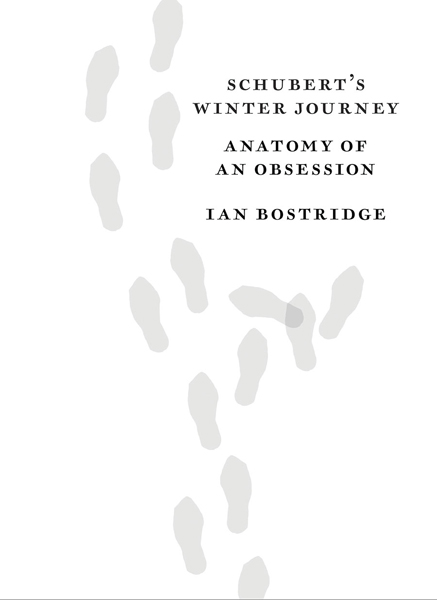
Tenor & Musicologist
Tenor Ian Bostridge enjoys an international career on both the opera and concert stage, and his recordings have won all the major international record prizes and been nominated for 14 Grammys. He was awarded his D.Phil from Oxford in 1990.
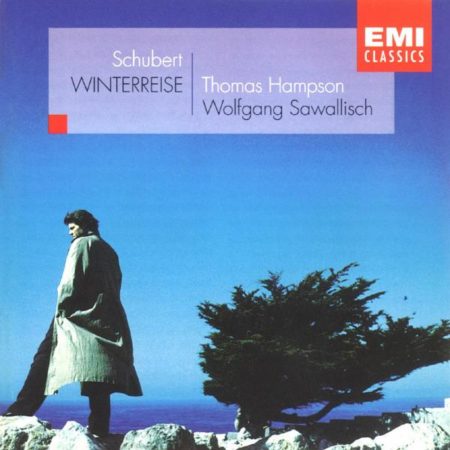
Schubert’s Winterreise
‘Schubert’s Winter Journey: Anatomy of an Obsession’ by Ian Bostridge

How many roads must a man walk down? The narrator of “Winterreise” (“Winter Journey”), Franz Schubert’s 1827 song cycle on Wilhelm Müller’s poems, has had to leave home, walking through an increasingly frozen landscape. He is an archetypal Romantic hero: enigmatically afflicted (some sort of heartbreak is implied, but never elucidated), psychologically burdened, in self-aware thrall to his emotions. Insistently expressive but narratively opaque, “Winterreise” demands explanation even as it renders explanations mundane, a challenge that has compelled generation after generation of performers. (Dietrich Fischer-Dieskau, the work’s most celebrated 20th-century interpreter, recorded it no fewer than seven times.) Audiences, too: As pianist Charles Rosen once wrote, the cycle “does not work upon the listener’s imagination but upon his nerves.”
“Winterreise” has done its work on the imagination and nerves of tenor Ian Bostridge, over a long period (Bostridge estimates that he has sung the cycle at least a hundred times), a passion distilled into “Schubert’s Winter Journey: Anatomy of an Obsession,” a diverting, deceptively digressive tour. Organized as 24 somewhat self-contained essays — each one exploring one of the cycle’s songs — Bostridge casts his net wide, from the literary significance of glaciers to the taxonomy of birds to Bob Dylan himself. The frost on the window in “Frühlingstraum” (“Spring Dream”) invites a scientific and poetic history of snowflakes and ice. “Gefrorne Tränen” (“Frozen Tears”) prompts a telling memory of a performance Bostridge gave in Moscow, which leads to a meditation on Napoleon’s invasion of Russia, the Nazi siege of Stalingrad, and the course of German nationalism. The common thread is classical music’s energetic paradox, a paradox the book embodies rather than explains: that art created in a very specific — and, often, very foreign — place and time can nevertheless meaningfully speak to an ever-different here and now.
Much of Bostridge’s exploration comes from a performer’s perspective: cogent explanations of the niceties of musical notation and interpretation, close readings of the text. And much of it reflects back on Schubert himself, his friends, his milieu, the syphilis that darkened his final years and killed him at 31, the year after he wrote “Winterreise.” (Schubert corrected proofs of the cycle on his deathbed.) But the book also approaches from myriad scholarly and historical angles, vectors Bostridge — who trained as a historian — chooses with judicious flair. For “Die Post” (“The Mail”), Bostridge emphasizes the contemporary ironic contrast between the Romantically evocative hunting horns and the horn on the newfangled mail coach — a warning against hearing the song as cozy nostalgia. With “Rast” (“Rest”), he unpacks the meaning of the abandoned charcoal-burner’s hut where the traveler stops to rest, teasing out reference to the turbulent politics of the day, and both Müller’s and Schubert’s subtle, radical dissidence.
The cycle’s most famous song, “Der Lindenbaum” (“The Linden Tree”), prompts an especially wide-ranging mix of past and present: Renaissance botany, Romantic imagery, German nationalism, Thomas Mann, Marcel Proust. In Bostridge’s telling, such detail is not extra weight on the journey, but a wind at the back. Throughout, whether aiming from past to present or present to past, Bostridge is eager to expand the music’s possibilities, to expand the reach of its allusive web — so much so, that when Bostridge expresses skeptical exasperation over the relevance of the open question of Schubert’s sexuality (a major controversy in early 1990s musicological circles), it feels dissonant, a rare instance of a potential interpretive avenue being closed off, rather than opened up.
Advertisement
Far more often, Bostridge’s curiosity enriches the book and the music. Discussing the song “Mut” (“Courage”), with its defiantly cheerful denial of God, Bostridge joins the text, Schubert’s religious attitudes, and Schubert’s art under the banner of John Keats’s “negative capability,” that is, “capable of being in uncertainties, mysteries, doubts, without any irritable reaching after fact and reason.” Bostridge himself reaches after fact, but out of a determination to honor the mysteries. The continuing power of “Winterreise,” a power the book idiosyncratically but effectively evokes, is to be found (or, as the case may be, not found) in the work’s multitudes, of moods, images, hidden answers, clear obscurities.
To fix such ambiguity in notation and then reconstitute it in performance is music’s great challenge, but also its great coup. Willa Cather left an artful suggestion of the duality in her 1935 novel “Lucy Gayheart.” Cather cites “Winterreise” early in the story: The title character, having traveled from Nebraska to Chicago to study piano, hears the cycle sung by Clement Sebastian, an older singer with whom she falls in love. Sebastian is killed on a journey abroad; Gayheart returns home. But, in a way, she has never left — as a girl of 13, she had run through fresh cement in front of her house, and the footprints remained, frozen in motion: “the print of the toes was deeper than the heel; the heel was very faint, as if that part of the living foot had just grazed the surface of the pavement.”
Lucy Gayheart herself dies, too young, falling through ice and drowning; many years later, Harry Gordon, the local banker who courted her, who spurned her, returns to the Gayheart house. Lucy’s teenage flight is still there, remembered in cement. Gordon pauses “mechanically on the sidewalk, as he had done so many thousand times, to look at the three light footprints, running away.” Such is “Winterreise”: a getaway captured, a preserved transience, even after countless revisits, still there and still fleeting.
Matthew Guerrieri is the author of “The First Four Notes: Beethoven’s Fifth and the Human Imagination” and writes frequently on music for The Boston Globe and NewMusicBox.
Academia.edu no longer supports Internet Explorer.
To browse Academia.edu and the wider internet faster and more securely, please take a few seconds to upgrade your browser .
Enter the email address you signed up with and we'll email you a reset link.
- We're Hiring!
- Help Center

Review of Ian Bostridge, Schubert’s Winter Journey: Anatomy of an Obsession

I reviewed this for a new, web-only independent book review site. It seemed like a good opportunity to speak to a wider audience about a book that has gotten a lot of media attention.
Related Papers
World Academy of Science, Engineering and Technology International Journal of Humanities and Social Sciences Vol:15, No:4, 2021
Maria de Fatima Lambert
Following previous studies about Writing and Seeing, this paper focuses on the aesthetic assumptions within the concept of Winter Journey (Voyage d’Hiver/Winterreise) both in Georges Perec’s Saga and the Oulipo Group vis-à-vis with the creations by William Kentridge and Michael Borremans. The aesthetic and artistic connections are widespread. Nevertheless, we can identify common poetical principles shared by these different authors, not only according to the notion of ekphrasis, but also following the procedures of contemporary creation in literature and visual arts. The analysis of the ongoing process of the French writers as individuals and as group and the visual artists’ acting might contribute for another crossed definition of contemporary conception. The same title/theme was a challenge and a goal for them. Let’s wonder how deep the concept encouraged them and which symbolic upbringings were directing their poetical achievements. The idea of an inner journey became the main point, and got “over” and “across” a shared path worth to be followed. The authors were chosen due to the resilient contents of their visual and written images, and looking for the reasons that might had driven their conceptual basis to be. In Pérec’s “Winter Journey” as for the following fictions by Jacques Roubaud, Hervé le Tellier, Jacques Jouet and Hugo Vernier (that emerges from Perec’s fiction and becomes a real author) powerful aesthetic and enigmatic reflections grow connected with a poetic (and aesthetic) understanding of Walkscapes. They might be assumed as ironic fictions and poetical drifts. Outstanding from different logics, the overwhelming impact of Winterreise Lied by Schubert after Wilhelm Müller’s poems is a major reference in present authorship creations. Both Perec and Oulipo’s author’s texts are powerfully ekphrastic, although we should not forget they follow goals, frameworks and identities. When acting as a reader, they induce powerful imageries - cinematic or cinematographic - that flow in our minds. It was well-matched with William Kentridge animated video Winter Journey (2014) and the creations (sharing the same title) of Michael Borremans (2014) for the KlaraFestival, Bozar, Cité de la musique, in Belgium. Both were taken by the foremost Schubert’s Winterreise. Several metaphors fulfil new Winter Journeys (or Travels) that were achieved in contemporary art and literature, as it once succeeded in the 19th century. Maybe the contemporary authors and artists were compelled by the consciousness of nothingness, although outstanding different aesthetics and ontological sources. The unbearable knowledge of the road’s end, and also the urge of fulfilling the void might be a common element to all of them. As Schopenhauer once wrote, after all, Art is the only human subjective power that we can call upon in life. These newer aesthetic meanings, released from these winter journeys are surely open to wider approaches that might happen in other poetic makings to be.
Journal of the American Musicological Society
Natasha Loges
This article traces the concert performance history of Schubert’s song cycle Winterreise, D. 911, during the second half of the nineteenth century. It begins by presenting a two-part theoretical framework, according to which the songs are understood as ontologically related to Friedrich Schlegel’s idea of the fragment, while the theoretical and practical treatments by musicians, critics, and scholars are viewed in relation to Walter Benjamin’s contrasting ideas of the “collector” and the “allegorist.” It then examines the practices of key figures such as the baritone Julius Stockhausen, a pioneer in lieder performance, and his circle, including Clara Schumann and Johannes Brahms. Their performance and programming strategies are then contextualized against a larger statistical survey of the Winterreise songs in public concerts within the Austro-German realm, drawing on surviving concert programs and press reports. This shows that, in performance, individual songs were treated as fragments to be reassembled in many ways, inviting fresh interpretive possibilities on the part of listeners. Further contextualization is provided by a brief survey of Winterreise in print and as discussed in critical writing, revealing that here too there existed different approaches to the work as “whole” and “fragment.” Ultimately, I argue that the coherence of such cycles is not intrinsic but constructed over time by multiple actors—performers, listeners, publishers, and critics—and that an awareness of this creates new possibilities for the understanding and performance of multipart works.
Anthony Gritten
Musical Times 141/1872 (Autumn 2000), 58-59
Intersections: Canadian Journal of Music
Murray Dineen
Journal of the Society for Musicology in Ireland
Anne Hyland
A review of Barbara M. Reul and Lorraine Byrne Bodley (eds), The Unknown Schubert (Aldershot: Ashgate, 2008), ISBN 978-0-7546-6192-4
Evan Williams
Schwanengesang is a posthumous collection of fourteen lieder written by Austrian composer Franz Schubert (1797-1828) during the months of August and October in 1828. These settings of poems by Ludwig Rellstab, Heinrich Heine, and Johann Gabriel Seidl explore deep feelings of lost love, pain, sadness, regret, departure, fate, and death. While the words were not his own, his musical language and selection of the poems illustrate the composer’s fascination with these subjects, who might have been aware of his coming death. This paper examines Schubert's health and mental state in his last months, along with five of his lieder, and argues that his compositional output in this time period was strongly influenced by the knowledge of his impending death.
Stephen Emmerson
This thesis comprises a detailed motivic analysis of Schubert's song cycle Winterreise. It consists of eight chapters. The introduction explains the rationale underlying the thesis; although numerous songs from Winterreise have been previously analysed in detail and found to have considerable motivic coherence, no clear tonal or motivic plan to the cycle as a whole has yet been identified. In contrast, numerous authorities have identified a high level of motivic coherence and unity in many of Schubert's other major songs and instrumental works. The thesis investigates whether such a structure exists for the whole of Winterreise rather than only in individual songs. The introduction also briefly explains the methodology to be used. Chapter 2 provides background on what actually defines a set of songs as being a cycle and also discusses existing scholarly research undertaken on Schubert's other major cycle Die Schöne Müllerin, composed four years prior to Winterreise. In a...
Wolfgang Marx
Review of the book by Lauri Suurpää (Bloomington: Indiana University Press, 2014), in Journal of the Society for Musicology in Ireland 11 (2015-16), 49-55, http://www.music.ucc.ie/jsmi/index.php/jsmi/article/view/144/151.
Cory Howell
One of Schubert's greatest works, that he barely finished before his death at age 31, was Winterreise. A song cycle based on the poems of the poems of Wilhelm Muller, Winterreise is a musical voyage for solo voice and piano that deals with the dark themes of rejection, sorrow, loneliness, and death. The paper analyzes the 24 songs of the cycle, demonstrating the powerful relationship between text and music, and between voice and piano, in this great vocal work.
Feuce Deportes
Article of despression by Schubert
RELATED PAPERS
Acta Chemica Scandinavica
Brain Research
Andrea Mastrangeli
vanusa fagundes
Calidad en la educación
andrea ruffinelli
Revista Ibero-Americana de Ciências Ambientais
Valdiney Ferreira de Almeida
Cirugía y Cirujanos
Rodrigo Corona
Antonis Fragedakis
Tecno-Lógica
Graciele Rediske
Journal of Contemporary Mathematical Analysis
Karen Avetisyan
International Journal of Current Aspects
stephen ajayi
O MUNDO DA ANESTESIOLOGIA E CONTROLE DA DOR NA MEDICINA VETERINÁRIA: DIVERSAS ESPÉCIES E SUAS PARTICULARIDADES
Raphaela Bueno Mendes Bittencourt
Montse Casanovas
Journal of Ecological Engineering
Muhammad Musa
Acta Crystallographica Section E Structure Reports Online
ACS Medicinal Chemistry Letters
Richard Sabina
Human Genetics
Stephanie Devaney
Acta Polytechnica CTU Proceedings
American Journal of Transplantation
David Mulligan
Patricia L Busk
The Minerals, Metals & Materials Series
Ivan Skalický
Environmental geochemistry and health
Eduardo Silva
Biology & Medicine Case Reports
Nader Mosavari
Sandra Ventura
Impiego di composti deuterati per studiare l'effetto della qualità del carburante sulle emissioni veicolari
Angelo Montebruni
hjfgffg hkjyt
RELATED TOPICS
- We're Hiring!
- Help Center
- Find new research papers in:
- Health Sciences
- Earth Sciences
- Cognitive Science
- Mathematics
- Computer Science
- Academia ©2024

Total Guide to plan & book a great Trans-Siberian Railway Trip
31. December 2020
Destination The World
This post may contain affiliate links, where we may receive a small commission if you purchase something through following the links at no extra cost to you.
Sharing is caring!
- Pinterest 14
It’s slow travel at its best, taking you from one continent to another, through big cities, over the Siberian steppes and along the largest lake in the world. Without a doubt, a Trans-Siberian Railway trip will take you on the greatest railway journey in the world. This legendary adventure stretching over eight time zones is one of the best travel experiences you can have, and no other rail journey can compare to the Trans-Siberian Railway.
Travelling the Trans-Siberian Railway is a dream for many people, and for one of us, this ultimate adventure was a lifelong dream. Doing this trip independent can seem like a bit of a challenge, and it also did for us in the start. The questions can be many but read on. This blog post has all the answers on how to travel the Trans-Siberian Railway independently. We will also shortly present the stops we had en route and give you some suggestions on what to see there, as an idea, while you start planning your journey.
1. Planning your Trans-Siberian Railway trip
We chose the classic, original route, starting in Moscow, before ending in Vladivostok, and we had our Trans-Siberian Railway trip in winter. That is just one way of doing it, but the options are many.
There are many things to consider when you start planning your journey, but first things first. A trip with the Trans-Siberian is perfectly safe, both for families, solo and female travellers. It is the way Russians have travelled for years, and very few reported incidents. Take precautions, choose your berth wisely, and take care of your belongings.
A journey like this requires some planning. But if you are like us, then you also find planning your trip half the fun.
Checklist for planning your Trans-Siberian Railway trip:
- When do you prefer to travel? Which season?
- Do you want to travel eastbound or westbound?
- Which visas will you need to organise? Check visa requirements
- Make sure that your passport is valid six months after you return
- What should be your final destination?
- Which route should you choose?
- How much will it cost?
- Do you want to stop along the route? Where?
- Organise travel insurance
The above list gives you a brief overview of things to take into consideration when planning your trip. What you choose will mostly depend on your wishes, budget and the time you have on hand.
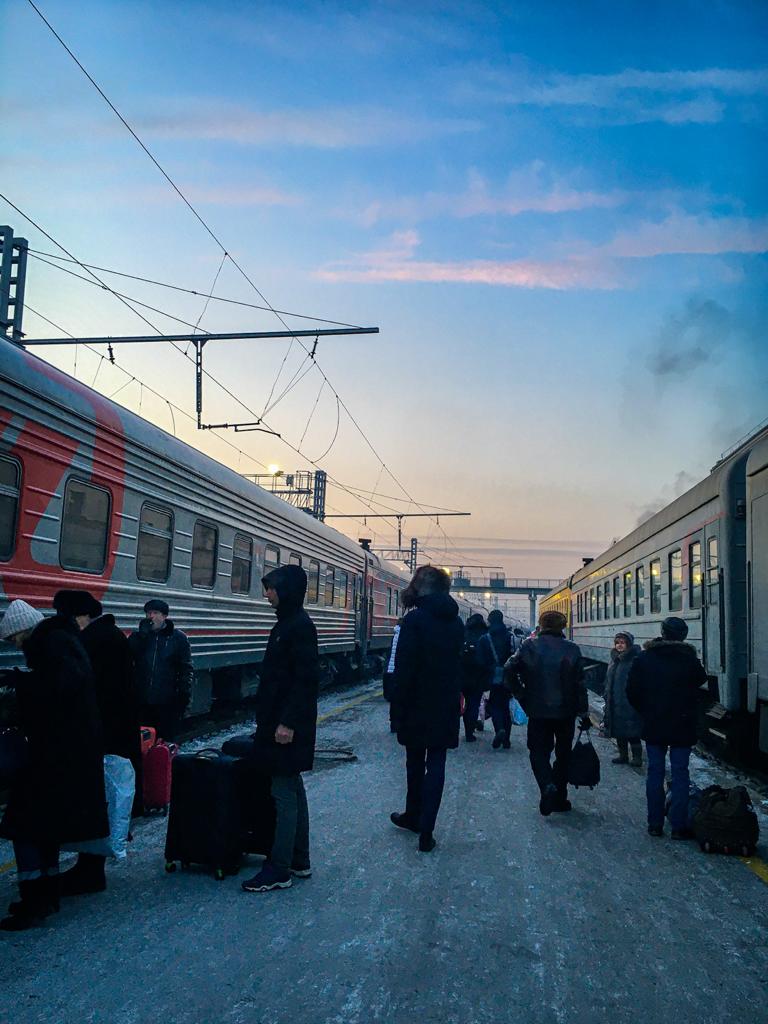
2. Best time to travel the Trans-Siberian Railway
If there is one best time to travel on the Trans-Siberian Railway or not, is really up to you and what you prefer. The train runs all year round, and each season has something to offer. Some periods are busy or warm while others are freezing cold.
Trans-Siberian in summer
Summer is the most popular time of the year for a Trans-Siberian Railway trip. With the summer holiday in the western world, lots of travellers find themselves onboard the train. It can get busy and harder to find tickets for some routes. The summer months are great if you travel solo and want to meet other fellow travellers.
The climate in Russia is mild, but July and August can get very hot. The same goes for Mongolia. Even the summer is shorter in Mongolia it really can get warm also there. China is hot and humid in the summer months.
Trans-Siberian in autumn
Autumn is by many considered the best time to travel the Trans-Siberian. It is less crowded, the worst heat is gone, and the foliage let you catch the autumn colours along the route. The weather can still be nice the whole route. In China, the humidity from the summer is gone.
Trans-Siberian in winter
A Trans-Siberian trip in the winter is spectacular. Yes, it can get freezing cold, like in really Siberian cold, and you will see that Siberia looks like yes, Siberia. The trains are heated and, you can expect to sweat even in winter. But to snug up inside while watching the Siberian winter pass by outside the windows is a magical feeling.
It is much fewer passengers in the winter, so it never gets crowded, and finding tickets is rarely a problem. Bring lots of warm clothes (think layers of clothes) for exploring the places you choose to stop.
Winter is considered the best time to visit Lake Baikal with its clear thick ice perfect for winter activities. The lake usually freezes from mid or end of February and last at least throughout March.
Trans-Siberian in spring
The spring is maybe the least recommended time for a Trans-Siberian Railway trip. It is no longer winter and also not summer. In late spring when the snow has melted, and nature starts to wake up is also very pretty. China has pleasant weather in the spring.
Spring is also not the busiest time on the train. It’s great for avoiding crowds and, tickets are available.
TIP: Read our post on the Harz Mountain Railway or the Zittauer Schmalspurbahn in Germany if you would like a nostalgic journey with a steam train

3. Choose your Trans-Siberian Railway route
The Trans-Siberian Railway is not one train route, but it’s a network of railways connecting Moscow with the Russian Far East. The building of the railway started in 1891 and finished in 1916. Train services ran along the route much before its completion. Today, the expansion of the railway system continues, with connecting routes to China, Mongolia, Japan and North Korea.
You can choose from three main routes, but the Trans-Siberian Railway also has several other options for connections along with its extended network. You don’t have to follow the same route the whole time, and you can combine more routes in one journey.
Eastbound or Westbound?
You can make your Trans-Siberian Railway trip in both directions. The choice is up to you and what you prefer. The eastbound route tends to be more popular among western travellers, so westbound is recommended if you are looking to avoid too many other travellers.
Usually, you will have to book one long-haul flight. Either to start the journey or when you have finished. Check airfares before you decide, it can be a big difference in costs depending on where and when you fly.
BUDGET TIP: In case you end your journey in Vladivostok, you save big bucks on flying domestic back to Moscow, and then have your international flight out from there, instead of flying out from Vladivostok
We chose eastbound from Moscow for two reasons. Firstly we found it kind of more romantic to start our adventure with the long train journey first, instead of with a long haul flight. Secondly, starting our winter trip with the Trans-Siberian in Moscow, also gave us the chance to celebrate New Year’s Eve there before we boarded the train the next day.
TIP: Read our post with tips and attractions in Moscow for a Moscow city break
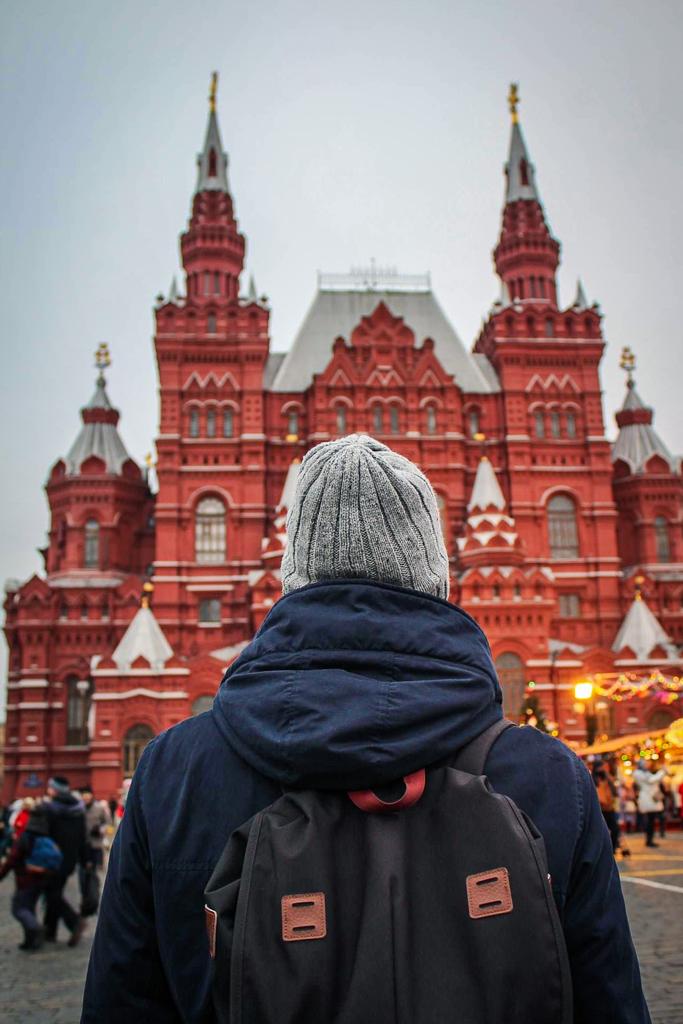
Trans-Siberian line: Moscow to Vladivostok
The legendary and original mainline from Moscow to Vladivostok is mostly following the historic path over the continent. Trains leave Moscow daily for this 9,259 km long journey. Depending on the train number, this route takes at least 143 hours, or around six full days. It can take longer. Some of the trains have slightly different routes or more stops en route.
The prime choice for this route is train number 1/2, the Rossiya. Train 1 is westbound and, train 2 is eastbound. Rossiya is regarded as the best train along this route, with the best comfort, service and food. It is also the most expensive one, so if you’re on a budget, consider doing only shorter legs with this train, and combine it with other trains, e.g. train number 62.
- Train number 1/2 has daily departures, in both directions
- Train number 61/62 departs Mon, Thurs, Sat, both directions
- If you plan to stop on your way, it is also possible to travel by trains that follow the same route but doesn’t go all the way to Vladivostok. It is still the Trans-Siberian Railway.
- Train number 70 will take you from Moscow to cities like Yekaterinburg, Novosibirsk or Irkutsk. In any of these cities, you can catch up with train number 2 or 62.
- For stops before Irkutsk, you can travel with the trains going to China and Mongolia and later change to trains for Vladivostok.
Trans-Manchurian line: Moscow to Beijing via Manchuria
This route takes just over six days for travelling 8,986 km. Train number 19/20 has weekly departures to or from Beijing via Manchuria (train 19 is westbound and train 20 is eastbound). This train follows the mainline on the Trans-Siberian Railway between Moscow and Chita. Also here you can combine it with stops and other trains. This route is operated by Russian trains.
- Train number 19/20 departs Saturday nights from both cities
- This train does not go via Mongolia. You will need visas for Russia and China only
- Take this train if you wish to visit the Harbin International Ice Snow Sculpture Festival in China
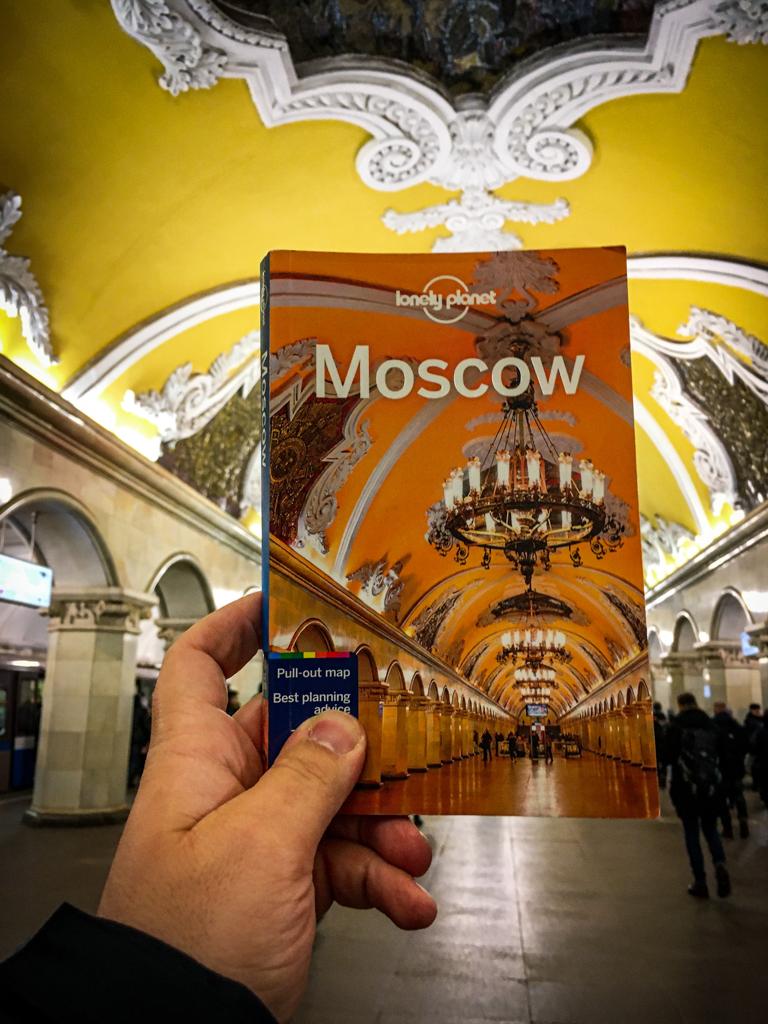
Trans-Mongolian line: Moscow to Beijing via Ulaanbaatar
This is the most popular route for western travellers on a Trans-Siberian Railway trip. This route is 7,621 km and takes 6 nights. With this train, you will have the chance to experience three different countries with their unique cultures. After travelling over Siberia, this train cuts across Mongolia and the Gobi desert before entering China.
TIP: Read our post on the Oslo to Bergen train an incredible beautiful train journey
The major train on this route is the weekly train number 3/4 (train 3 is westbound and train 4 is eastbound). This route is operated with Chinese trains, but when in Russia, a Russian restaurant car is attached, then later a Mongolian before a Chinese restaurant car for the last part of the trip is attached.
- Train 3 departs Beijing every Wednesday
- Train 4 departs Moscow every Tuesday
- Between Moscow and Ulan Ude you can combine this route with all other trains
- Most travellers on this train need a visa to Russia and China, and some also to Mongolia
Other routes
There are other alternative routes to take on your Trans-Siberian Railway trip as well, where you later can connect with the mainline to Vladivostok, or with the trains to China.
One route runs via Kazan, the capital and largest city of the Republic of Tatarstan in southwest Russia. Another option is the train via Yaroslavl, northeast of Moscow. Yaroslavl is part of the Golden Ring of ancient towns in Russia.
TIP: Read our post on the best places to visit in Russia’s Golden Ring
4. Choose your Trans-Siberian Railway stops
When you have chosen your preferred route for your Trans-Siberian Railway trip, it is time to choose your stops. It is possible to travel the whole journey in one go. But we do recommend stopping en route to your destination. Russia has so much to see, so it would be sad to miss out on a stop there.
Depending on the time you have, you can almost have unlimited stops. If you follow the mainline, there are several interesting places in Russia to visit. Perm, Yekaterinburg, Omsk, Novosibirsk, Irkutsk (Lake Baikal) and Ulan Ude are all recommended places to stop, among many others.
We chose two stops along the route, in Yekaterinburg and Irkutsk. If you have limited time, and can’t do too many stops, these two cities will give you many options to explore Russian culture, cities and nature.
Best things to do in Yekaterinburg
Yekaterinburg just west of the Ural mountains is the gateway between Europe and Asia. With a population of over 1,3 million, it is a major Russian city. The history goes long back but is maybe most famous for being the city where former president Boris Yeltsin came to rise, and also for being the city where Russia’s last monarchs, the Romanov family were executed.
The city centre is lively, with a mix of grand old and communist-era style buildings. The city has good cafes and restaurants. After some time on the train, a break here can be very welcome. If you visit Yekaterinburg in the winter, the city has a small ice sculpture festival in the city centre.
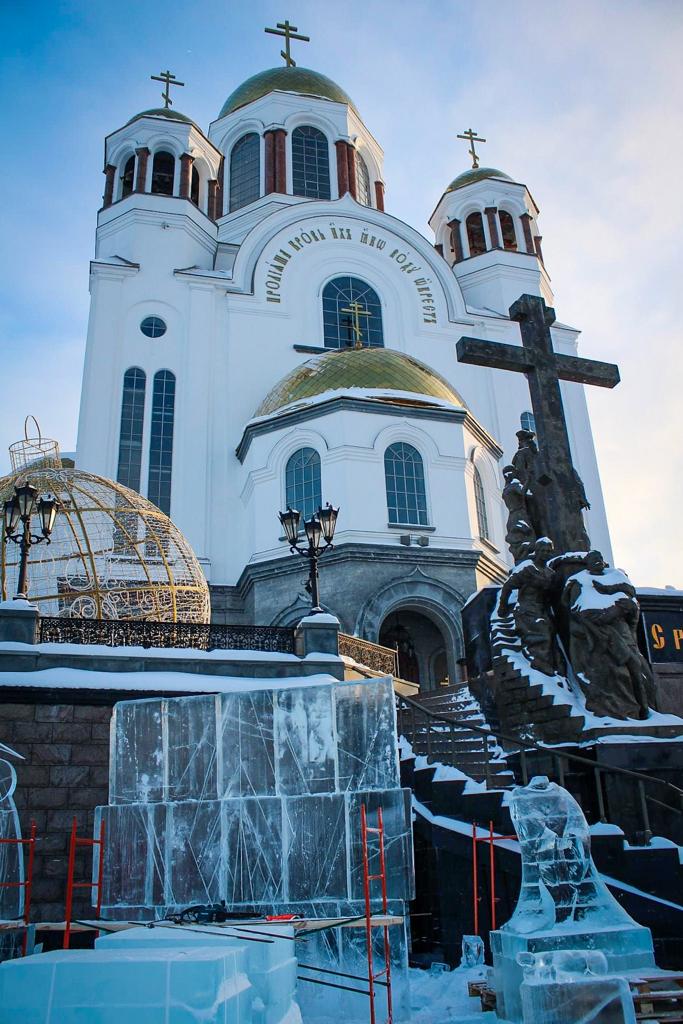
If you like opera or ballet (and think Bolshoi in Moscow is too expensive), Yekaterinburg has an excellent opera and ballet house showing first-class productions throughout the year. We were lucky and got good tickets for The Nutcracker for only €50.
If you’d like a detour out of the city, you can visit the Europe-Asia border, located 40km west of the city. Yekaterinburg For You can arrange the trip for you.
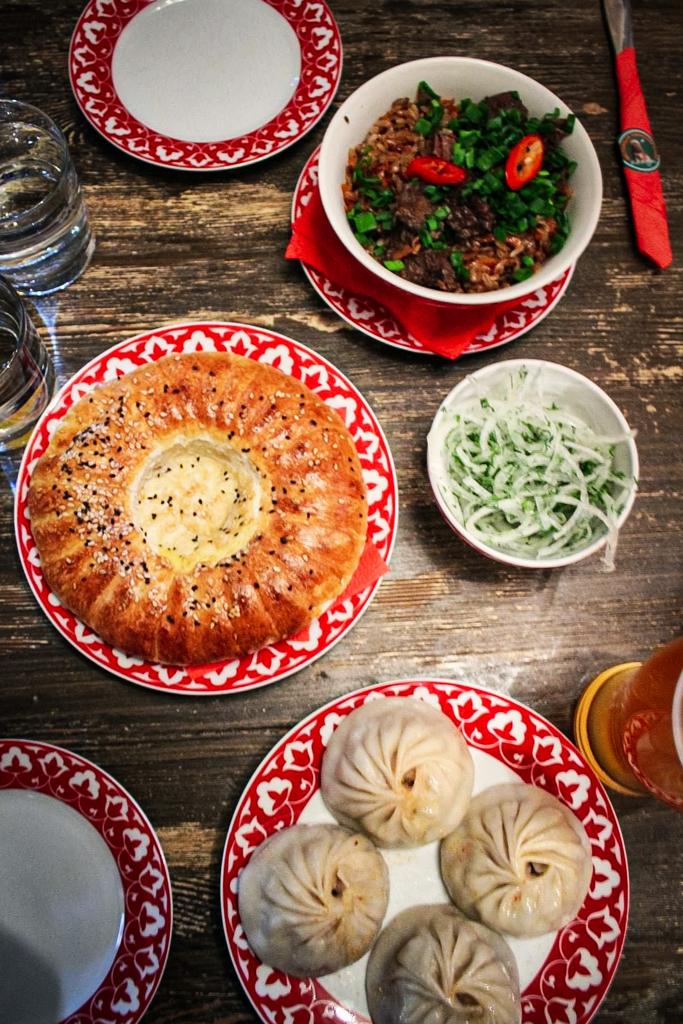
Our highlights in Yekaterinburg:
- Visit the Church upon the Blood. This is the death site of Tsar Nicholas II and his family
- See the mansion house of Sevastyanov
- Watch an opera or ballet at Ural Opera & Ballet . Book tickets in advance
- Eat excellent Uzbek food at the restaurant Nigora
- Visit the Ascension Church
- Enjoy the mix of architectural styles
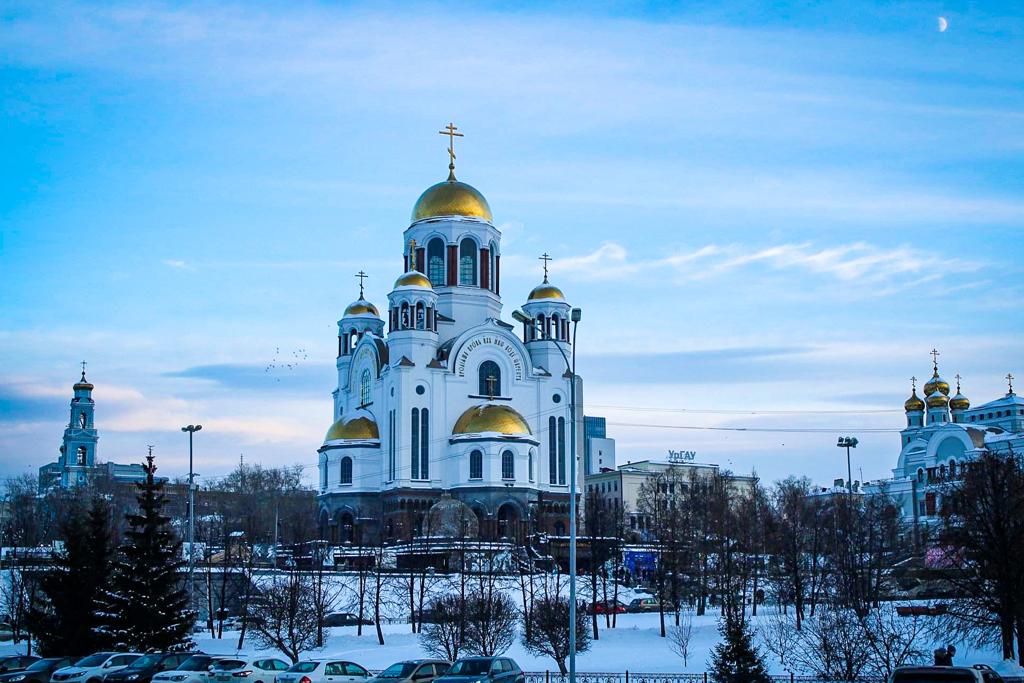
Best things to do in Irkutsk
This Siberian city is such a hidden treasure. Irkutsk is beautiful. One of the best things to do there is simply to wander around its streets and take in the beauty of the city.
From streets full of beautifully crafted wooden houses to spectacular churches and monasteries, Irkutsk really was a pleasant surprise. The food scene in the city is also great. Cute cafes serve delicious breakfasts, trendy cafes have excellent coffee and restaurants serve mouth-watering Asian food.
TIP: Read our post on Flamsbana Railway in Norway . It is said to be one of the most beautiful train journeys in the world
Irkutsk is the gateway to the famous Lake Baikal. You can visit the lake on a day trip from Irkutsk, or better spend a night or two. Most hotels and hostels in Irkutsk can help arrange trips to Baikal. The nearby, lakeside village of Listvyanka is a good starting point for exploring Lake Baikal. You can reach the village by hourly bus from outside the tourist office in Irkutsk.
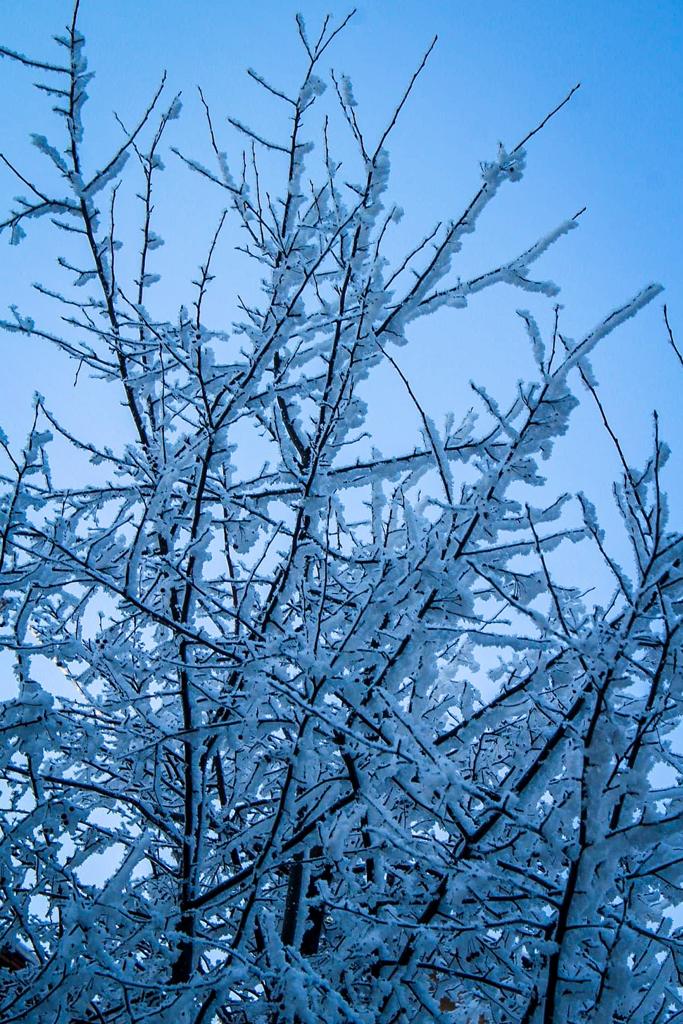
Our highlights in Irkutsk:
- Wandering along the river and the streets to look at all the cute wooden houses and churches
- Visit the amazing Kazan Church of Irkutsk
- Visit Znamensky Monastery
- Eat excellent Asian food and Russian dumplings
- See the Epiphany Monastery
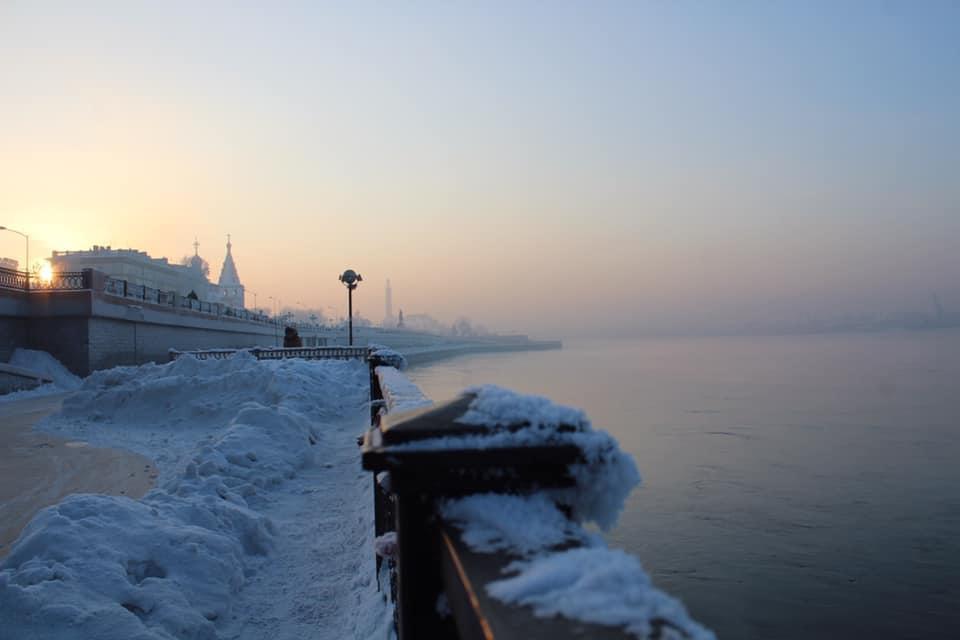
5. Classes on the Trans-Siberian Railway
Of the regular trains, train number 1/2, the Rossiya , has the best standard. It is very comfortable, but don’t expect luxury even when travelling on this train.
There are usually two or three classes to choose from when booking your ticket, but this may vary from train to train, season and demand. The berths (rooms) don’t vary that much. It is more about the space, and how many you will share the berth with.
Which class you should choose depends on your wishes and your budget. If you value privacy, choose the first class. If you travel on a budget, choose the third class. On the other hand, if you want to meet the locals as they travel, choose this class as well. Choose the second class for anything in between.
To get the best experience of a Trans-Siberian railway trip, we would recommend a mix of the classes (if you have stops along the route). It will give you unforgettable memories with locals, and ensure some privacy and calmness on the trip.
First class
1st class berths, known as Spainy Vagon or SV , on Russian trains are usually the same as 2nd class, but only the lower beds as used, meaning you only share the berth with one other person. On Chinese trains, known as deluxe sleeper , you normally sleep in the upper bed and can relax on a sofa during the day.
On trains without first class, it is possible to buy out the whole berth for single-use or to buy out the left-over beds in your berth if you are more people travelling.
The luggage is stored under the lower beds, and the berth is equipped with a reading light and electric socket. There are toilets and washrooms at each end of the wagon. Some trains have a shower available. Ask your train host if your train has showers for rent.
Second class
Usually, 2. class is known as Kupe, which are 4-bed berths with two upper and two lower beds. The lower beds function as a sitting area during the daytime. Expect to share your lower bed with passengers from the upper bed during the day, e.g. for meals. The second class on Chinese trains is called soft sleeper .
The luggage is stored under the lower beds, and the compartment is equipped with a reading light and electric socket. There are toilets and washrooms at each end of the wagon.
Third class
The third class, known as platskartny , has an open plan with 54 bunks per wagon, arranged in groups of 4 or 2. Here you will have a lack of privacy, but on the other hand, you are guaranteed nice encounters with your fellow passengers.
If you are travelling on a tight budget, the third class will be the best option. It is significantly cheaper than the higher classes.
Private luxury trains
If you have the money and are looking for a once-in-a-lifetime experience, one of the private luxury trains could be the option for you. Here you travel in a secluded world, with meals, excursions and the best comfort included. It is expensive, so only expect to meet other wealthy travellers on this train. The downside is that you won’t have many encounters with the locals if you choose one of these trains.
Check Golden Eagle or Imperial Russia for more information on private luxury trains.
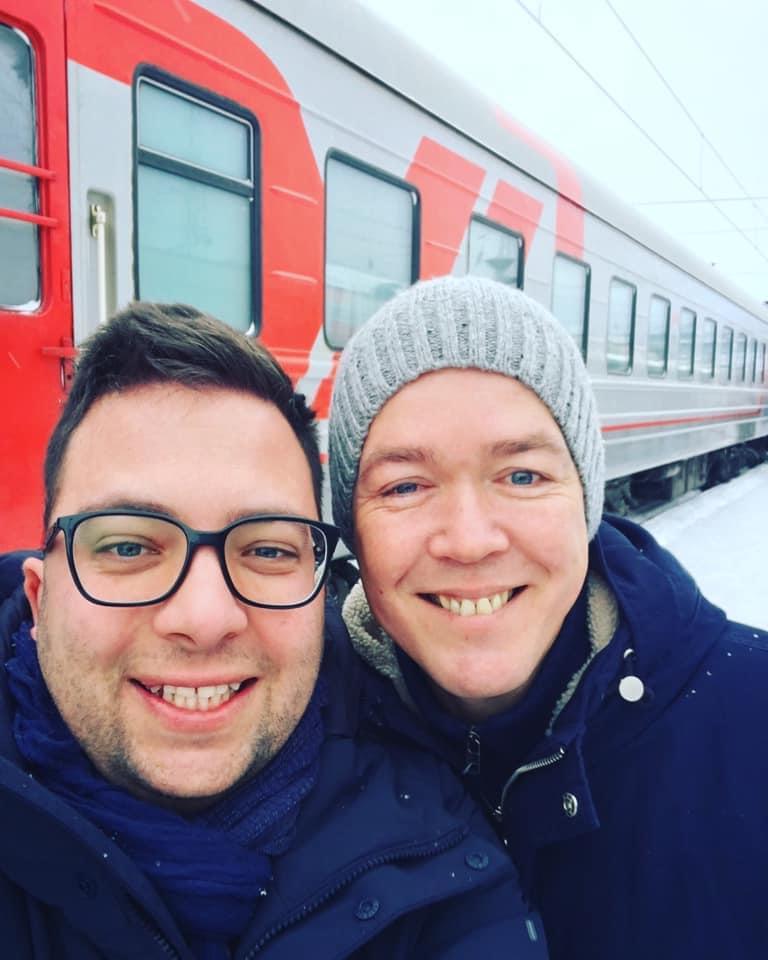
6. How much does the Trans-Siberian cost?
It’s a myth that a Trans-Siberian Railway trip is very expensive. On the contrary, when thinking of the distance travelled, it comes out as very affordable indeed.
In addition to the Trans-Siberian-Railway ticket itself, there are some additional costs you need to add:
- Costs for the visa(s)
- Health insurance
- Flights (or other transport) to start and endpoint
- Accommodation before and after the train ride, plus at the stops you make
- Food and drinks
- Personal expenses
The price of the train tickets depends on the time of year you travel, and your preferred class. The high season is June to August when the ticket prices are at the highest. Also around Russian New Year and Christmas, the prices rise. The same goes for the Chinese train around Chinese New Year.
In general, it is cheaper to travel the whole Trans-Siberian without stops, as you then travel on the same ticket the whole way. Making stops will raise the ticket cost, but not that much. The more stops you make, the higher the total cost you will get (when you stop you have to buy several independent tickets).
Your travel class will affect the ticket price the most, and in general, a first-class ticket is around double of a second-class 4-berth ticket. The lower bed is more expensive than the upper bed. Some tickets on certain trains also include one or a few meals, but far from all the meals, you’ll need.
Price example (per person) from our Trans-Siberian Railway trip (January 2020):
- Train number 70 Moscow-Yekaterinburg, 2nd class, 4-bed berth, lower bed: €68/ $83
- Train number 2, the Rossiya , Yekaterinburg-Irkutsk, 2nd class 4-bed berth, upper bed:€129 / $158
- Train number 100 Irkutsk-Vladivostok, 2nd class, 4-bed berth, upper bed: €121/ $149/ lower bed: €157 / $193
Total price Moscow-Vladivostok with two stops: €672/ $825, or only €336/ $412 per person. With more stops, the price will go up, and without stops, it will go down, but the difference is really not that much.
Tickets from Moscow to Beijing can cost as little as €550/ $680, but the real bargain is on the classic route from Moscow to Vladivostok.
As seen above, it is possible to make a Trans-Siberian Railway trip quite cheap. If you travel only third class, you can save more, and first-class would cost around double. The total price for the whole trip will then more depend on your choice of accommodation before, during and after the trip, and how much the flights or other transport costs before and after the train itself. With budget accommodation and low-cost airlines, it is possible to do this whole trip for less than €1000/ $1230, food and activities not included, if you live in Europe.
Expect to pay much more if you use a travel agent. Should you prefer to book via a travel agency, you will get the best deal from local offices in China or Mongolia, while the western ones usually will be the most pricey option.
For private luxury trains, you should expect to pay more than €10,000 (up to €20,000). And that’s per person!
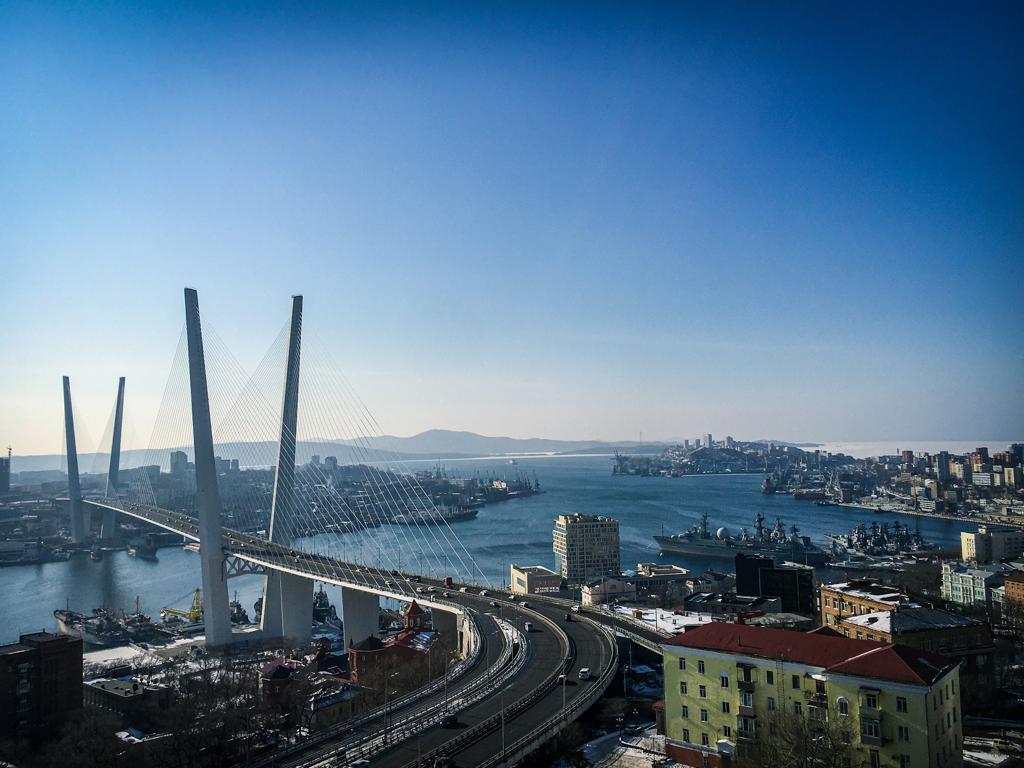

7. How to book Trans-Siberian Railway tickets?
When you have decided your route and planned which stops your Trans-Siberian railway trip should have, it is time to book your tickets.
Booking tickets to the Trans-Siberian Railway is surprisingly easy and straightforward. There is no need to ask a travel agent at home or in Russia to do this for you. Expect to pay much more if you use a travel agent.
Tickets are available for booking 60 days before departure. Especially in the high season, it is recommended to book in advance, but often it is possible to find tickets 2-3 days in advance online or at the train stations in Russia. The Trans-Mongolian line is popular and can sell out due to only one departure per week. Book way ahead unless you are very flexible on time.
During the booking process, you can choose between available berths and between upper or lower beds. You can also choose between mixed-gender or female berth only. Smoking is prohibited anywhere on the train, so you don’t have to fear smoking in your compartment.
TIP: There are toilets at each end of the wagons. If the toilet is full, it can stink really bad, also in the corridor and berths close by. Choose your berth in the middle of the wagon.
How to book tickets at the Trans-Siberian railway (for trains starting in Russia)
- Go to the official website of the Russian Railways (site in English)
- Click on log-in or registration to create a profile (mandatory before booking)
- Type in from/to and date and search
- Click on the from-price in the class you prefer, and see which berths are available
- Choose your berth, and if you want an upper or lower bed
- Fill in personal information, confirm, and pay (NB: you need to add your passport number)
- Voila! You have your ticket
- Tickets work electronic but, we recommend a print-out in case of battery issues
PLEASE NOTE: This way of booking is at the moment only available for trains starting in Russia. You can not book tickets online on this site for trains starting in China or Mongolia. Some US-issued credit cards may get rejected.
How to buy tickets on trains starting in China and Mongolia:
- You can not buy tickets for the Trans-Siberian Railway at Beijing stations
- The CITS international train booking office is recommended for purchasing tickets in China and Mongolia
- In Ulaanbaatar, you can buy tickets at the international ticket office next to the train station
8. Life onboard the Trans-Siberian Railway
A journey on the Trans-Siberian Railway is slow travel at its best. Prepare yourself for days on the tracks with many fellow passengers coming and going. The encounters with fellow passengers, tourists and locals, will be some of the most memorable moments of this trip. Keep in mind that the Trans-Siberian is not run for tourists. It is as it’s meant to be; a passenger train made for transporting many people over long distances. Don’t expect nightclubs and entertainment onboard.
Even though you will spend hours and days onboard the train, you hardly will have time to get bored. Somehow, the days pass by as the Siberian landscape slowly glides by outside your window. Relax, watch the scenery outside, read, play a game, listen to music or podcasts or watch a downloaded movie or series. Talk with your fellow passengers, stretch your legs at the stops, have a drink and enjoy your journey. That’s all that it’s about!
Please note that onboard the train, they always use Moscow time. Time tables show both Moscow and local time. Keep track of the time zone, and you will manage.
Before boarding the train
Essential items to pack
- Comfy clothes
- Slip-on footwear
- Electric adapter
- Toilet paper
- Bottled water
- Instant food
Arrival and boarding
- Trains in Russia are punctual
- Check the name of the station closely
- Arrive latest 30 min before departure
- Platform and track will be displayed in the departure hall
- Keep tickets and passports safe but available for inspection

Arrival on the train
Upon arrival, you will meet your train host, the provodnitsa. She is the boss, your best friend, and must be obeyed. Each wagon has its provodnitsa, and on long trains, they work in pairs (one works while the other rests). They only speak Russian and can seem very strict and fearsome, but mostly they are friendly and helpful.
On arrival, she will check your ticket and provide you with the bed linen. Her most important task is to keep her wagon clean, tidy and warm. She also makes sure that the samovar (water boiler) at the end of the corridor always contains hot water for your use.
At the beginning of the journey, they usually also offer some souvenirs or snacks they have for sale. Buy something, and you have a friend and helper for the rest of the journey. If you need something, like plates, cups or cutlery, you can often borrow it from her (for a small tip).
Your compartment
Depending on if you travel solo, as a couple or in a small group, usually, you share your compartment with other passengers, unless you have bought all beds. Be polite, greet fellow travellers and try to interact with them.
You can be lucky or not so lucky with your roommates, but that’s also a part of the experience. Put baggage under the seats, and keep personal belongings in your bed. Respect that people want to sleep in the night, and expect fellow passengers to come and go at all times as the train stops frequently.
If you have the lower bed, you are expected to make room for passengers in the upper bed to sit in your bed and share the table at meals. Not everyone is so happy with doing this, but all passengers have the right to use the table.
TIP: If you are two travelling together, book one lower and one upper bed on the same side. Then you can rest whenever you want, and sharing the lower bed as a daytime sofa and the table is never a problem.

Meals on board
Let’s be honest: don’t expect your Trans-Siberian Railway trip to be a culinary journey. In that case, you will get deeply disappointed. If your ticket includes some meals, you will get them brought to your compartment. Every train has a restaurant car, with various decorations. The food in the restaurant car is disappointing and nothing special. It is quite pricey for such low quality.
Try the food in the restaurant car as part of your experience. But don’t have all your meals here. Eat most meals in your compartment, and rather use the restaurant car for a drink or two during the day. It is a good place to meet other travellers.
Buy instant food, like noodles, soups and stews before you board the train. The samovar in your wagon always has hot water you can use. Stock up on fruits, crackers and other dry food items. When the train stops for more than just a few minutes you can buy more food at the stations along the route.

Short stops along the route
The many shortstops along the route are one of the highlights during the day onboard. Sometimes the train stops for just a few minutes and other times for anything between 30 minutes to an hour. Each wagon is equipped with a timetable showing the stops along the route. The timetable states arrival and departure times at each stop.
When the train only stops for a few minutes, it can be worth getting off to get some fresh air and stretch your legs. Don’t be late back. The train will not wait for you.
Life on the stations is some of the most fun and memorable moments of this journey. Passengers come and go, and everywhere it’s busy activities. Small stalls sell fresh or preserved food, drinks, fruits and sweets. Locals often also offer local products for sale. It can be handcrafted items, souvenirs, food and drinks. Often you can find fresh bread on the stations, and in some places, you can also find warm food. Try the smoked fish offered at the stations in Siberia. It’s delicious and a good supplement to all the instant food.

Click on the pin to save it to Pinterest
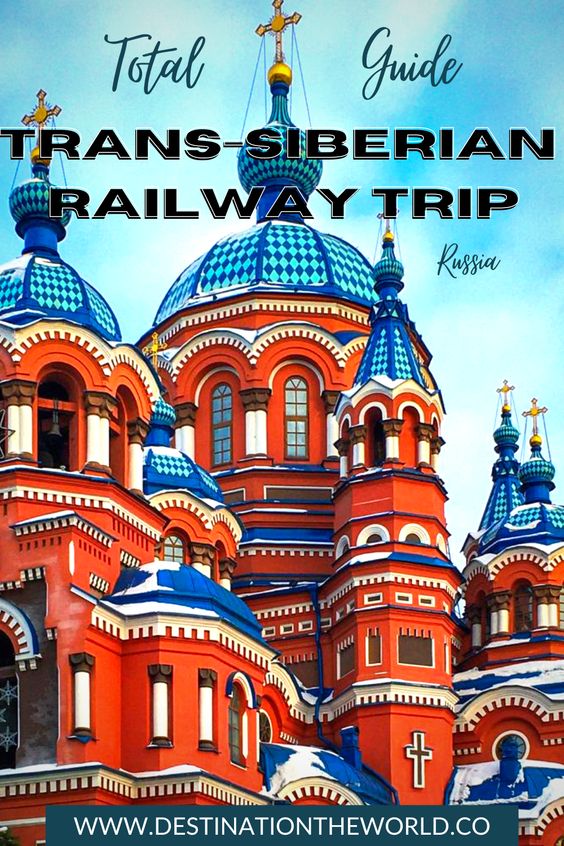
2 thoughts on “Total Guide to plan & book a great Trans-Siberian Railway Trip”
Hello guys!! Just loved your blog on the transiberian. It cleared my mind and encourage us to a future trip. Have fun and enjoy life as you two always do and maybe our paths will cross some day on a post covid dream trip. Big hugs from Monterrey, Mexico.
Thank you very much for your feedback! Trans-Siberian is such a great adventure that we would recommend to everyone.
Comments are closed.

We are Matthias and Kent. With a strong desire to travel the world, we create articles and travel guides from our many trips. We aim to inspire you to explore the world, near and far. Maybe your next adventure is closer than you think?
Destination guides
Download free Russia travel guides
- St Petersburg
- Golden Ring
- Lake Baikal
- Murmansk (Kola Peninsula)
- Moscow & St Petersburg
- Russia River Cruises
- Expedition Cruises
- Trans-Siberian Tours
- Northern Lights Tours
- Siberia Tours
- Winter Tours
- Students Trips
- Luxury Tours
- Plan My Tour
Start planning my tour
Your Russia, your dates, your mates
- Destination Guides
- Russia Travel Tips
- Russian Visa
- Travel Insurance
- Why 56th Parallel
- Traveller Reviews
Northern Lights in Russia: Arctic Winter Magic
Duration 12 days
Price from AUD $4,666 ? Currency Conversion Converted from USD based on the latest exchange rate. Final amount and payment will be in USD. Final conversion rate is determined by your bank.
Trip Style Cultural, Northern Lights
Time of year Dec - March
Home / Moscow Tours / Northern Lights in Russia: Arctic Winter Magic
Dates & Prices
Russian winter turns cities a dazzlingly photogenic white, and reveal the true beauty of the Kola Peninsula, whose Arctic skies are often graced with the mythical Aurora Borealis.
Russian winters are harsh yet extraordinarily beautiful, and it’s the lands above the Arctic Circle where winter's transformational effects are most keenly felt. The Kola Peninsula is home to people and animals who not only survive but thrive despite the chilling temperatures. Ending in the 'capital' of the Arctic Circle, Murmansk, this Northern Lights tour shows you two sides to life in the Russian Winter, from the grandiose cities of Moscow and St Petersburg to the polar landscapes of the remote Kola Peninsula.
Northern Lights in Russia tour highlights:
- Moscow City Tour: Begin your journey in Russia’s mighty capital discovering Moscow's highlights. Start with a guided exploration of the Kremlin in its finest winter decorations, before heading underground to discover the famous Moscow Metro system and its lavishly decorated subterranean stations
- Armed with the knowledge of an expert guide, uncover some of the most esteemed treasures among the 3 million works of art in St Petersburg’s State Hermitage Museum
- Hovercraft Ride: Visit the small rural settlement of Kizhi Island, today an enchanting open-air museum with over 80 original wooden structures from the 14th to 17th centuries. In the middle of Lake Obega, Kizhi is only accessible in winter via a hovercraft able to navigate the icy, aquatic terrain
- Polar Nights and Astral Lights: Crossing into the Kola Peninsula, you'll spend four nights above the Polar Circle where the chance to experience the Northern Lights in all their splendour is a tantalising prospect each evening
- Visit one of the Kola Peninsula’s largest indigenous Saami settlements. Learn about their ancient culture, customs and cuisines and try your hand at essential Saami skills like reindeer lassoing and husky sledding
On this trip to see the northern lights in Russia, we begin in Moscow, where the city’s monuments, parks and churches are transformed into a scene from a winter fairy tale, all icing sugar snow and shimmering lights. Next, we head north to Saint Petersburg, where you can enjoy world-class attractions like the Hermitage at a leisurely pace, free of the tourist crowds typical of the summer months.
Forging closer to Arctic Circle, we’ll stop to admire the Ruskeala Mountain Park, spending a day absorbing the park's natural beauty, including shimmering waterfalls and the amazing, 100m deep Marble Canyon. During winter evenings, the canyon is illuminated by a dream-like display of multi-coloured lights. Next, we'll navigate the icy waters of Lake Onega on a day trip to historic Kizhi Island.
Finally, we’ll cross into the Polar North, arriving in the Kola Peninsula by train. Discover the customs of the indigenous Saami and traverse their snowy lands in sleds pulled by huskies and reindeer. Finally, we reach Murmansk, the largest city in the Kola Peninsula. While there’s the possibility to observe Aurora Borealis throughout our time in the Kola, Murmansk and the surrounding area is regarded as one of the best places in the world to experience the psychedelic light display in all its awe-inspiring glory.
This tour perfectly encapsulates the charm, allure and beauty of both urban and rural Russia in winter. From the cities to the mountains to the Arctic Circle, you'll witness magical sights and scenes that can only be experienced in the season of ice, snow and amazing astral projections that light up the darkest winter nights in unforgettable fashion.
Accomodation
Cultural, Northern Lights
Action rating ?
Type of tour
12 days / 11 nights
min 2 people
Private tour
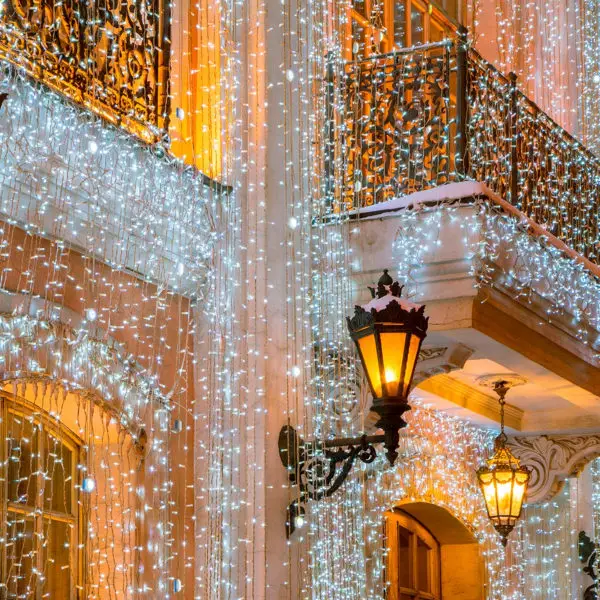
Itinerary View map
Day 1 welcome to moscow.
Arrive in Moscow and transfer to your centrally located hotel. Get your first taste of life in the Russian metropolis, exploring the city at your leisure.
Day 2 Moscow: Red Square, Kremlin and Armoury Chamber
Our first acquaintance with Moscow starts with a walking tour of the historical city centre. Almost every building in the historical centre of Moscow is associated with different events and celebrated personalities of Russian history and culture.
You will see and hear the stories of the most popular places in the city: Red Square , the hub of Russia, with its fantastic "stone flower"- St. Basil Cathedral , one of the symbols of Moscow; fancy Manezhnaya Square with the Zero Kilometer, a starting point for all Moscow roads; Alexander’s Garden with the eternal flame, a WW2 memorial, where you might watch a change of guards. These are places that make Moscow one of the most beautiful cities in Russia.
Have a delicious lunch in one of the multiple downtown cafes or restaurants and continue the day with a tour of the Kremlin grounds and Armoury Chamber . The Kremlin used to be a fortress then the residence of the Russian Tsars.
After the Revolution of 1917, the USSR Government moved in it. Now it is the seat of the Russian President and a unique cultural museum complex that consists of palaces, cathedrals and museums.
You will tour the grounds of the Kremlin and visit its strikingly beautiful cathedrals full of ancient frescoes and icons, such as Assumption Cathedral where Russian tsars and emperors were crowned; Archangel Cathedral - the burial vault of the Russian tsars until 18th centuries; and Annunciation Cathedral , a home church for the royalty.
You will get to meet the 2 prominent Russian tsars in person: the Tsar Bell and the Tsar Cannon , the biggest in the world. Kremlin will surely reveal you some mysteries of the Russian state and soul.
While touring the Kremlin you will also visit Armoury Chamber, famous for the Tsar's regalia such as jewellery crowns, orbs and sceptres, clothing of the Russian tsars and tsarinas, royal carriages, collection of arms and armour, gifts to the Russian Tsars from various countries of the West and the East, and the illustrious collection of Faberge Easter eggs.
Take your time to relax as we prepare something special as an option* for this evening. Head out for an unforgettable night at the opera or the Russian ballet at the iconic Bolshoi Theatre.
Day 3 Moscow: Panoramic tour, Metro and Tretyakov Gallery
Today, we explore Moscow further on a car tour of the city, giving you a sense of the city’s sheer size, and an impression of how Moscow has changed throughout the ages. Visit the starkly contrasting Theatre Square to see the stunning Bolshoi Theatre. Stroll along Tverskaya Street , the city’s main boulevard and home to the landmark Yeleseyevskiy Grocery Store , a former palace turned luxury providore.
We’ll also explore Boulevard Ring, where Russian nobles built their exquisite 18th and 19th-century mansions, and Kutuzoyskiy Avenue with its Triumphal Arch . Pass by the legendary Gorky Park and the White House before a stop at the architecturally stunning Novodevichy Convent , and the observation platform at Sparrow Hills , for a bird’s eye view over this staggering megalopolis.
Next, we visit the 19th century Tretyakov State Gallery , the world’s foremost depository of Russian fine art, containing over 130,000 exhibits, with work by Rublev, Kandinsky, Repin, and many others.
***The tour of Tretyakov Gallery can be changed to a tour of Pushkin State Museum of Fine Arts upon request.
We will also explore the Moscow Metro . Opened in 1935, this striking feat of engineering is one of the largest and oldest underground railway systems in the world. Its grand stations are remarkably beautiful and have become tourist attractions in their own right.
Day 4 St Petersburg city tour
In the morning, after breakfast at your hotel, you will be transferred to the train station, where you board a fast train Sapsan , which will take you for a 4h journey to your next destination St Petersburg – also known as the cultural capital of Russia. On arrival to St Petersburg, you will be met by a driver and transferred to your centrally located hotel.
Your second half of the day starts with meeting your professional and friendly St. Petersburg guide in the lobby of your hotel to enjoy a walking city tour of St. Petersburg with picturesque stops in most popular places and by most spectacular sights.
At this time of year, the city is at its most beautiful. The streets are relaxed and uncrowded, the iconic Neva River becomes a wilderness of ice, and the city’s gilded monuments glow against a backdrop of the winter sky and bare trees covered in crystalline frost.
Stroll along the Nevsky Prospect - the main street of St. Petersburg, cross the Anichkov Bridge and admire the Anichkov Palace. Walk along the banks of Fontanka and Moika Rivers, stop at the Kazan Cathedral and St Isaac's Cathedral , visit the Palace Square and Senate Square with the Bronze Horseman monument to Peter the Great, walk inside of the Church on the Spilled Blood and be amazed by its architecture.
During the tour, you will also visit the Peter and Paul Fortress and its Cathedral - a burial place of Russian emperors from Peter the Great to Nicholas II and his family.
As an option* for this evening, we invite you to enjoy the traditional Russian dance performance in Nikolaevsky Palace.
Day 5 St Petersburg: day trip to Pushkin and Pavlovsk
Experience the extravagance of the Imperial rulers on an excursion to the suburban estates of the Romanov Tsars. Tsarskoe Selo ( Tsar’s village ) is now part of the nearby town of Pushkin and is one of Saint Petersburg’s finest attractions. Amid exquisite parks and gardens, you’ll find the baroque Catherine Palace , a dazzling testament to Catherine’s love of luxury and royal excess.
Envision Catherine strolling with her beloved dogs through acres of private gardens, where remarkable structures like the Marble Bridge, the Dutch Admiralty and the Creaking Pagoda were constructed for her amusement. We also explore the stately neoclassical Alexander Palace, whose tumultuous history paints a fascinating portrait of the Romanov family and the replica of the world-renowned Amber Room .
You will also visit Pavlovsk Palace and Park , the summer palace of Emperor Paul I, commissioned by his mother Catherine the Great. The palace borders with a park of 600 hectares in area, which is one of the largest landscape parks in Europe.
If there’s one must-do in St Petersburg in winter, it’s a traditional troika ride! Perhaps the quintessential image of the Russian winter, a troika is a sled-like carriage drawn by three horses harnessed side-by-side. Be swept up in the magical winter scenery, passing beautiful wooded areas and meandering streams.
As an option* for this evening, we invite you to experience:
An evening of Russian classical music at one of St. Petersburg’s beautiful palaces. Take a seat in the magnificent Hall of the Palace, then, lose yourself in much-loved works by Russian composers such as Tchaikovsky, Shostakovich and others, played by one of the world-class orchestras of St Petersburg. Before the raising of the curtains, enjoy an interesting pre-concert tour of the palace's halls and a glass of sparkling wine.
Day 6 St Petersburg: The State Hermitage Museum
On our last day in St Petersburg, we pay a visit to its most lauded attraction. The State Hermitage Museum houses some 3 million masterpieces, spread across six magnificent historic buildings, including the splendid Winter Palace . Here you’ll feast your eyes on Rembrandts, Leonardos and Michelangelos, and get an up-close look at some of the world’s most important archaeological finds.
After lunch at a café in the Hermitage, you can seek to discover more of the museum at your own pace or head elsewhere.
As an option* for today, enjoy a tour (audio-guide) of the recently opened Faberge Museum , a private collection of over 4,000 Faberge Eggs and other bejewelled objects of desire, elegantly displayed inside the stunning Shuvalov Palace.
In the evening, we transfer from to the Ladozhsky railway station for the train bound to Petrozavodsk – the capital of Karelia, a scenic mid-sized town built along a bay on vast Lake Onega.
Day 7 Karelia: Ruskeala Park and Kinerma village
Your local guide will meet you at the Petrozavodsk train station, for a tasty hot breakfast at one of the city cafes. After a short tour of Petrozavodsk , you will embark on a scenic, several-hour-journey to the Ruskeala Mountain Park . Unique for its waterfalls and varicoloured marble quarries, the quarry pits were once mined to provide building material for the royal palaces.
The park is now protected and one of the most spectacular natural sites in the Karelia region. Its most famous attraction is the 100m high, 450m wide Marble Canyon, which is filled with crystal clear water from underground springs. In winter, the canyon is illuminated with multi-coloured lights – a truly unforgettable scene.
The return journey will take us back to Petrozavodsk. En route, we will stop at Kinerma village , which in 2016 was named the most beautiful village in Russia. We’ll be met by a local resident for a personalised tour around the village, made up of late 19th century houses and a wooden chapel to the Virgin Mary erected in the 17th century. Afterwards, we’ll be invited to dinner in a traditional Karelian house.
Closer to evening, you will be transferred back to your hotel in Petrozavodsk.
Day 8 Karelia: Kizhi Island
Today we visit the Kizhi Island in the centre of Lake Onega. Getting here in winter requires a ride on a hovercraft. Only a small rural settlement remains on Kizhi, and the island has become an open-air museum with over 80 historical wooden structures, some dating to the 14th century.
After returning to Petrozavodsk, it’s time to get ready for our overnight train, which will take us above the Arctic Circle.
Day 9 Kola Peninsula: Murmansk city tour
We have now crossed the northern polar circle and at arrived in Murmansk, the northernmost city in Russia, with a population of around 300,000 people, by far the largest city above the Arctic Circle. An important Russian naval base, Murmansk served as a port for the Arctic convoys during WWII.
After hotel check-in and lunch, we embark on the Murmansk city sightseeing trip, and a tour of the world’s first nuclear icebreaker ship, Lenin .
Spend your free evening discovering the surprisingly vibrant nightlife in this quirky Russian outpost. With any luck, the Northern Lights will make an appearance, we will go hunt this beautiful phenomenon.
Day 10 Kola Peninsula: Saami village and husky dog sledding
Head to one of the largest Saami settlements in the Kola Peninsula, where many traditional dwellings are still in use. The settlement was built around important grazing land for the Saami’s precious reindeers, who are surprisingly affectionate and enjoy being stroked and fed by visitors. Also look out for wildlife in the surrounding countryside, including polar foxes, hares and hunting birds.
You’ll get the chance to learn about the ancient Saami culture and be invited to play traditional games, test your lasso throwing skills and reindeer sledding abilities, and maybe even try on some traditional Saami clothing. The locals will put on an authentic lunch spread including fish soup, berry pie and herbal tea, after which you’ll be given the opportunity to purchase handicrafts.
After lunch, we head to a Siberian husky farm . Here, you’ll learn the wonderful story behind the evolution of this iconic northern breed, and spend time getting to know the charming resident dogs here as well as their reindeer stablemates. Take an exhilarating sled ride through the starkly beautiful winter forests with the Husky team.
In the evening, we get back into the hotel where we’ll spend the remainder of the evening.
Day 11 Kola Peninsula: Snow village and snowmobiling at Khibiny Mountains
We start our day with the chance to carve it up on a snowmobile safari in the Khibiny Mountains , making our way down the valleys for a sensational view of the mountain ranges. This experience doesn’t require any special skills or physical abilities. After a safety brief, you will truly feel yourself “in the saddle” and will be able to enjoy the stunning winter landscapes and tranquillity of the mountains.
Next destination is the Snow Village , an ambitious tourism project that has been running since 2008. The Snow Village has been painstakingly constructed almost entirely out of ice and snow and features ornately decorated buildings, sculptures and labyrinthine tunnels with intricately patterned rooms, walls and corridors. This enchanting place is the work of true artists and a chance to open your imagination to the magical spirit of winter.
Day 12 Departure from Murmansk
After breakfast, it’s time to check out of our Murmansk hotel. You’ll be transferred to the airport to catch a flight back to either Moscow or on to your next destination.

Print this page
Save a printed version of this tour, so you can make a decision later

Send to my inbox
Email yourself or a friend the link for this tour

Ask a question
Have a question about this tour? Our experts will be happy to help
3* hotels in Moscow, St Petersburg, Petrozavodsk and Murmansk
Breakfasts in the hotels, some lunches (download the detailed itinerary for more information)
Airport and train station transfers
All transportation, according to the itinerary
Local licensed English-speaking tour guides in each region
Professional drivers
All excursions, including entry fees
1 night of Northern Lights hunt
Train tickets
Russian tourist visa support document
Travel insurance
Russian visa and visa fees. *Russian visa can be arranged by 56th Parallel for an additional cost (for Australian citizens only). Apply for concierge visa service here .
Moscow to Murmansk
*Private tour, price is per person, based on min 2 people
Testimonials
Andrew Cherrett Australia
Everything was effortless and planned perfectly!
The hotels were great and the locations perfect! (the igloo hotel could do with some work, but the location made up for it). We tried lots of Russian food and restaurants, all were fantastic.
From our very first meeting your support & help has been amazing, I couldn’t ask for anything more & will recommend you to anyone thinking of visiting Russia. Additionally, the guides & drivers were fantastic, very helpful & perfect representation of Russia. Please pass this on to them & the companies.
Similar tours
Northern lights in russia – railway adventure to the arctic circle.
We invite you to feel the atmosphere of the magic of winter St. Petersburg, Petrozavodsk, Vologda and witness the Northern Lights beyond the Arctic Circle on the shores of the ...
Arctic Rail Explorer – Quest for Northern Lights
Take in the beautiful cities of St Petersburg and Moscow before exploring deep into the Russian and Norwegian Arctic Circle in pursuit of the magnificent Aurora Borealis (Northern ...
Dowlnload comprehansive info-kit for this tour, FAQ’s and extras
Why travel to Russia with 56th Parallel?
Destination Specialists
Our team offers over 18 years of experience travelling and planning travel in Russia. Delivering outstanding travel experiences in Russia’s capitals and in some of the most stunning & remote locations takes experience, special access and the right connections. We make sure that all the fine details are handled perfectly so you can enjoy your Russia travel experience.
Group & Private Tours
The choice to join a small group on a guaranteed departure or chose to travel on your own dates with your own mates. Each destination we travel to in Russia offers an option between private tours and small group tours. Please note: on our adventure tours in remote destinations, we mostly run group tours to keep the cost down.

Bonded & Licensed
56th Parallel is a fully licensed, insured and accredited travel provider.

From AUD $4,666
Day 1: Welcome to Moscow
Day 2: moscow: red square, kremlin and armoury chamber, day 3: moscow: panoramic tour, metro and tretyakov gallery, day 4: st petersburg city tour, day 5: st petersburg: day trip to pushkin and pavlovsk, day 6: st petersburg: the state hermitage museum, day 7: karelia: ruskeala park and kinerma village, day 8: karelia: kizhi island, day 9: kola peninsula: murmansk city tour, day 10: kola peninsula: saami village and husky dog sledding, day 11: kola peninsula: snow village and snowmobiling at khibiny mountains, day 12: departure from murmansk, not included, start planning your tour.
A destination specialist will follow up on you enquiry shortly. Prefer to chat? Call us on +61 412 587 785 we will be delighted to be of service.
Email this tour to:
Have a question or need specific information.
Send us a note below or call us
Country * Afghanistan Albania Algeria American Samoa Andorra Angola Anguilla Antarctica Antigua and Barbuda Argentina Armenia Aruba Australia Austria Azerbaijan Bahamas Bahrain Bangladesh Barbados Belarus Belgium Belize Benin Bermuda Bhutan Bolivia Bosnia and Herzegowina Botswana Bouvet Island Brazil British Indian Ocean Territory Brunei Darussalam Bulgaria Burkina Faso Burundi Cambodia Cameroon Canada Cape Verde Cayman Islands Central African Republic Chad Chile China Christmas Island Cocos (Keeling) Islands Colombia Comoros Congo Congo, the Democratic Republic of the Cook Islands Costa Rica Cote d'Ivoire Croatia (Hrvatska) Cuba Cyprus Czech Republic Denmark Djibouti Dominica Dominican Republic East Timor Ecuador Egypt El Salvador Equatorial Guinea Eritrea Estonia Ethiopia Falkland Islands (Malvinas) Faroe Islands Fiji Finland France France Metropolitan French Guiana French Polynesia French Southern Territories Gabon Gambia Georgia Germany Ghana Gibraltar Greece Greenland Grenada Guadeloupe Guam Guatemala Guinea Guinea-Bissau Guyana Haiti Heard and Mc Donald Islands Holy See (Vatican City State) Honduras Hong Kong Hungary Iceland India Indonesia Iran (Islamic Republic of) Iraq Ireland Israel Italy Jamaica Japan Jordan Kazakhstan Kenya Kiribati Korea, Democratic People's Republic of Korea, Republic of Kuwait Kyrgyzstan Lao, People's Democratic Republic Latvia Lebanon Lesotho Liberia Libyan Arab Jamahiriya Liechtenstein Lithuania Luxembourg Macau Macedonia, The Former Yugoslav Republic of Madagascar Malawi Malaysia Maldives Mali Malta Marshall Islands Martinique Mauritania Mauritius Mayotte Mexico Micronesia, Federated States of Moldova, Republic of Monaco Mongolia Montserrat Morocco Mozambique Myanmar Namibia Nauru Nepal Netherlands Netherlands Antilles New Caledonia New Zealand Nicaragua Niger Nigeria Niue Norfolk Island Northern Mariana Islands Norway Oman Pakistan Palau Panama Papua New Guinea Paraguay Peru Philippines Pitcairn Poland Portugal Puerto Rico Qatar Reunion Romania Russian Federation Rwanda Saint Kitts and Nevis Saint Lucia Saint Vincent and the Grenadines Samoa San Marino Sao Tome and Principe Saudi Arabia Senegal Seychelles Sierra Leone Singapore Slovakia (Slovak Republic) Slovenia Solomon Islands Somalia South Africa South Georgia and the South Sandwich Islands Spain Sri Lanka St. Helena St. Pierre and Miquelon Sudan Suriname Svalbard and Jan Mayen Islands Swaziland Sweden Switzerland Syrian Arab Republic Taiwan, Province of China Tajikistan Tanzania, United Republic of Thailand Togo Tokelau Tonga Trinidad and Tobago Tunisia Turkey Turkmenistan Turks and Caicos Islands Tuvalu Uganda Ukraine United Arab Emirates United Kingdom United States United States Minor Outlying Islands Uruguay Uzbekistan Vanuatu Venezuela Vietnam Virgin Islands (British) Virgin Islands (U.S.) Wallis and Futuna Islands Western Sahara Yemen Yugoslavia Zambia Zimbabwe
If you have any urgent questions or enquiries, please give us a call +61 412 587 785
- Bahasa Indonesia
- Slovenščina
- Science & Tech
- Russian Kitchen
7 things you NEED to do in Moscow this winter
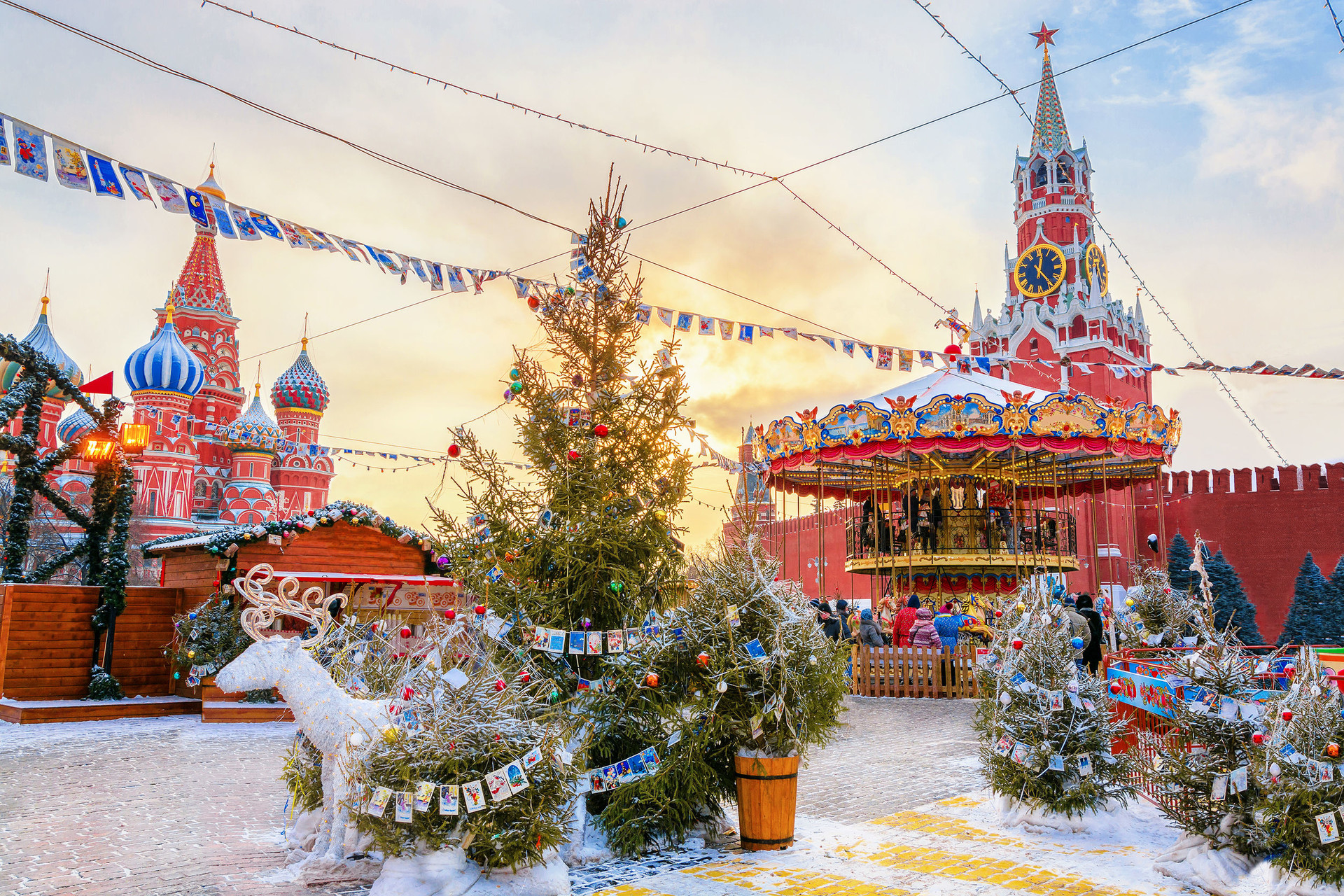
1. Get your skates on
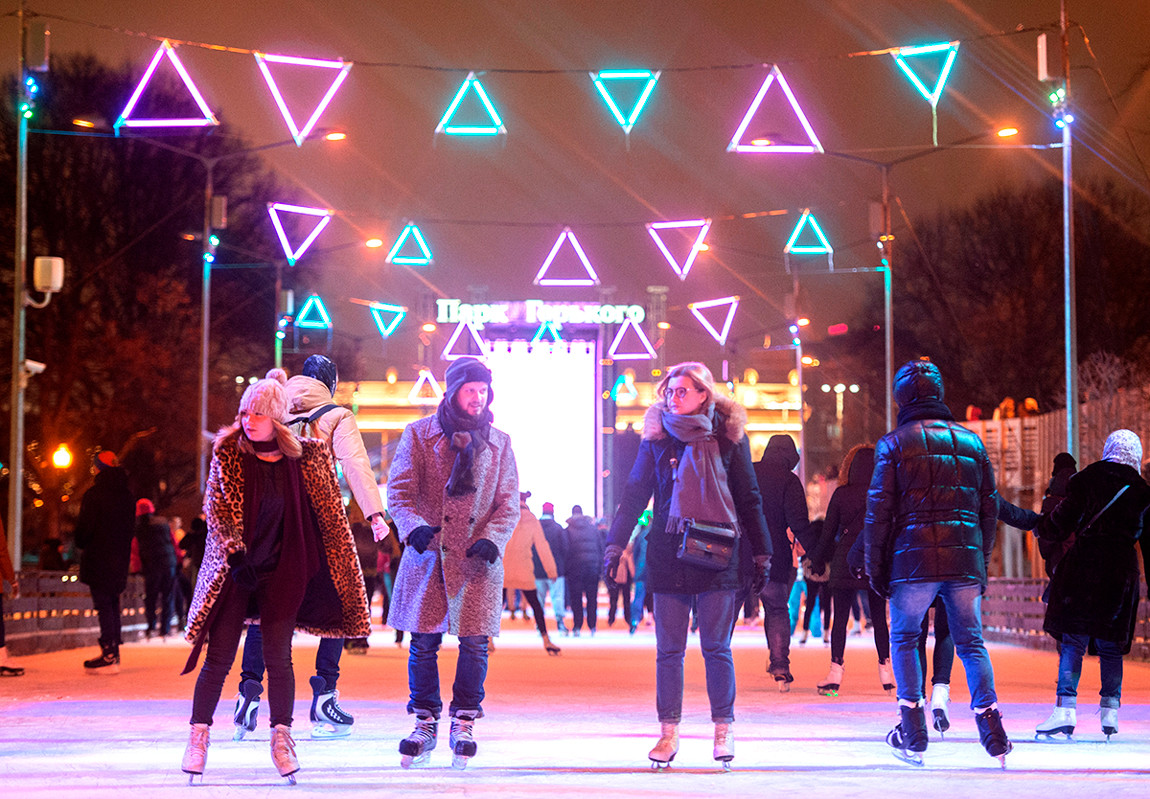
People at the opening of the Street Rink outdoor skating rink in Gorky Park, Moscow.
Young or old, sporty or couch potato, it doesn’t matter – ice skating is THE quintessential winter activity in which pretty much everyone Muscovite partakes. For that reason, Russians tend to be quite good at skating, but don’t let that put you off if you’re a beginner. Public ice skating is more about embracing the crisp winter mornings here than hardcore sporting endeavor, so expect high spirits and friendly atmospheres.
What’s more, there are a staggering 45 year-round skating rinks to choose from in Moscow. Gorky Park’s rink is a must-see that allows for pleasant strolling, coffee drinking, and art viewing afterwards. The VDNH rink is also worth checking out for the park that surrounds it, offering majestic light shows, fountains, and Soviet relics. For a more open-plan skating arena, head to Sokolniki Park, where you’ll find a whopping 5,400 square meter rink.
2. Sweat out the winter blues
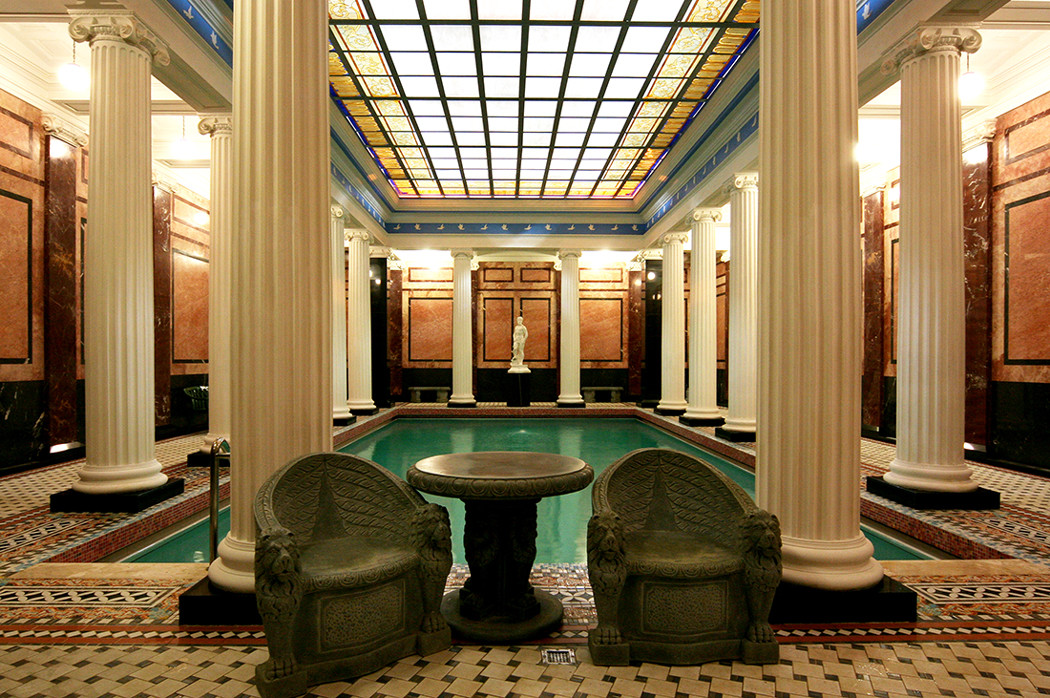
Sandunovsky baths
We challenge you to find a more relaxing atmosphere than a Russian banya . You simply won’t – this tradition will warm up your body and your soul. Sure, being practically boiled in a firewood sauna and then hit with a birch tree while half-drunk might not be everyone’s idea of fun, but trust us, they’re missing out on this unique detox.
Check out the Sanduny bathhouse for the most jaw-dropping Russian relaxation experience imaginable, characterized by palatial columns and mosaics, as well as stylish cold water pools for you to dive into after your beat-down. Happy steaming!
3. Light up your life
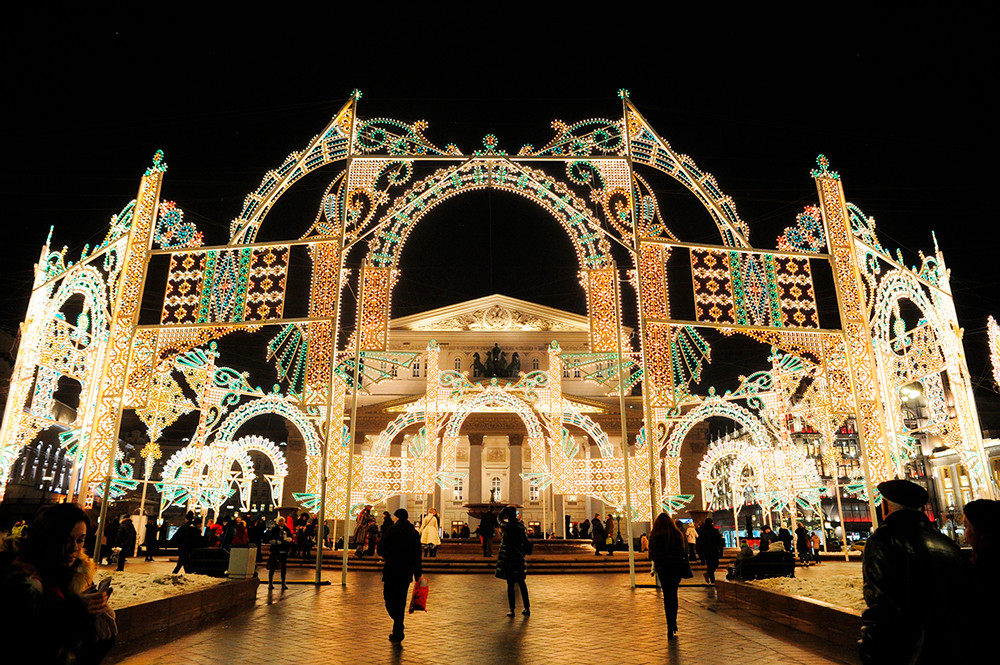
Teatralnaya Square
Moscow city center’s mesmerizing light display is not only the pride of the city, but of half of Russia too, who travel to the capital specifically for the luminous spectacle. In the lead up to New Year, the areas around Red Square, Teatralnaya Square, Nikolskaya Street, Pushkin Square, and Tverskoy Boulevard become a neon ocean.
The lights are a significant annual investment for the Moscow council, not least because they tend to replace the lights with new ones year on year, but it’s usually deemed worth it by admiring onlookers and tourists. If this display doesn’t get you in the festive spirit, nothing will.
4. Shout your lungs out at an ice hockey match
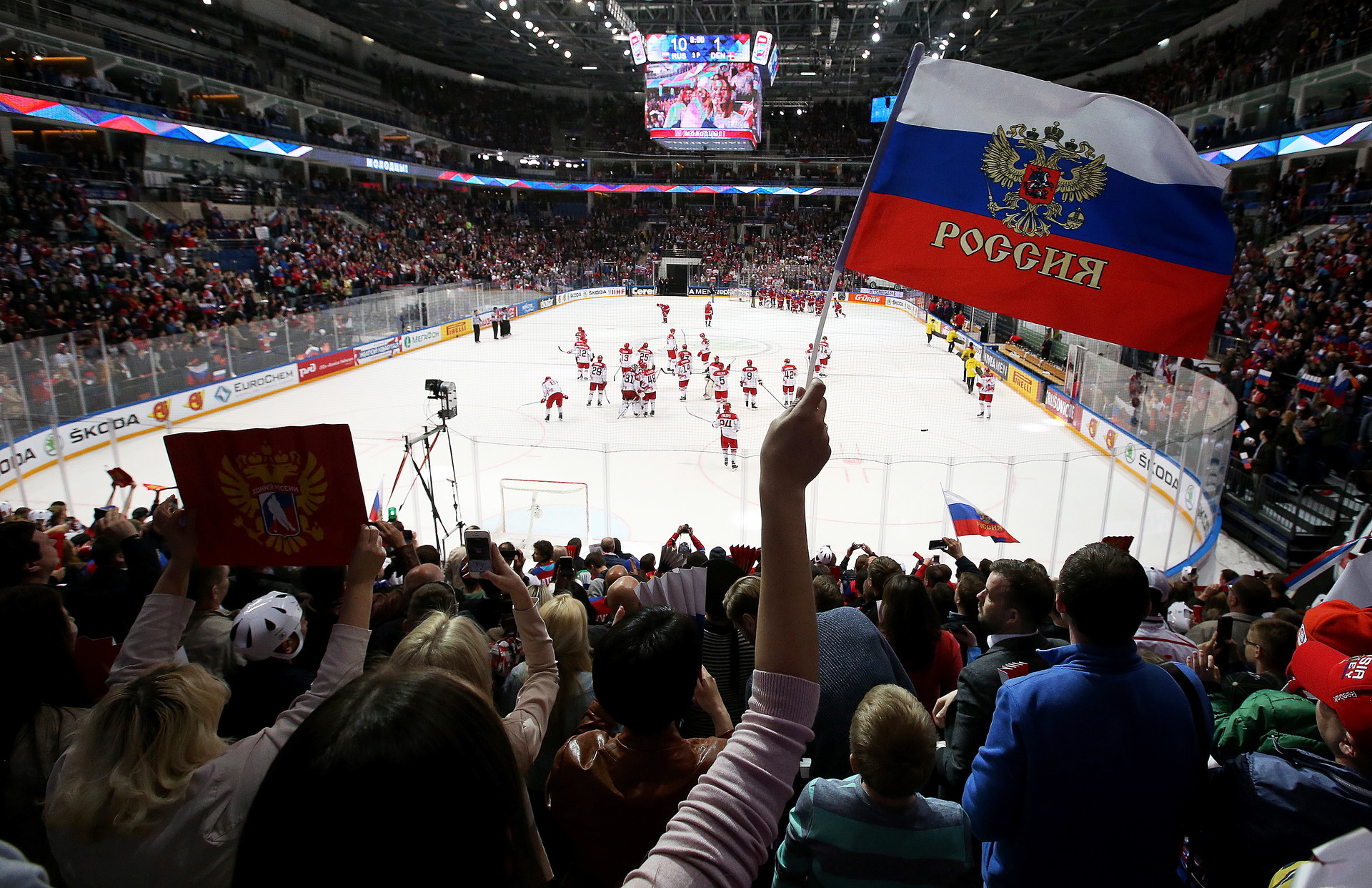
If there’s one sport Russians are particularly passionate about, it’s ice hockey. Go and experience the fierce athleticism, frequent on-rink fights, and rowdy crowds for yourself, and you’ll see what all the fuss is about. In contrast to Russian football matches, where there’s often little more than atmospheric novelty to be had, the country can take pride in having world-class hockey players, whose quality will be immediately obvious.
The best place for a match is the slick 12,100-seater VTB Ice Palace, home to CSKA’s ice hockey outfit.
5. Step back in time
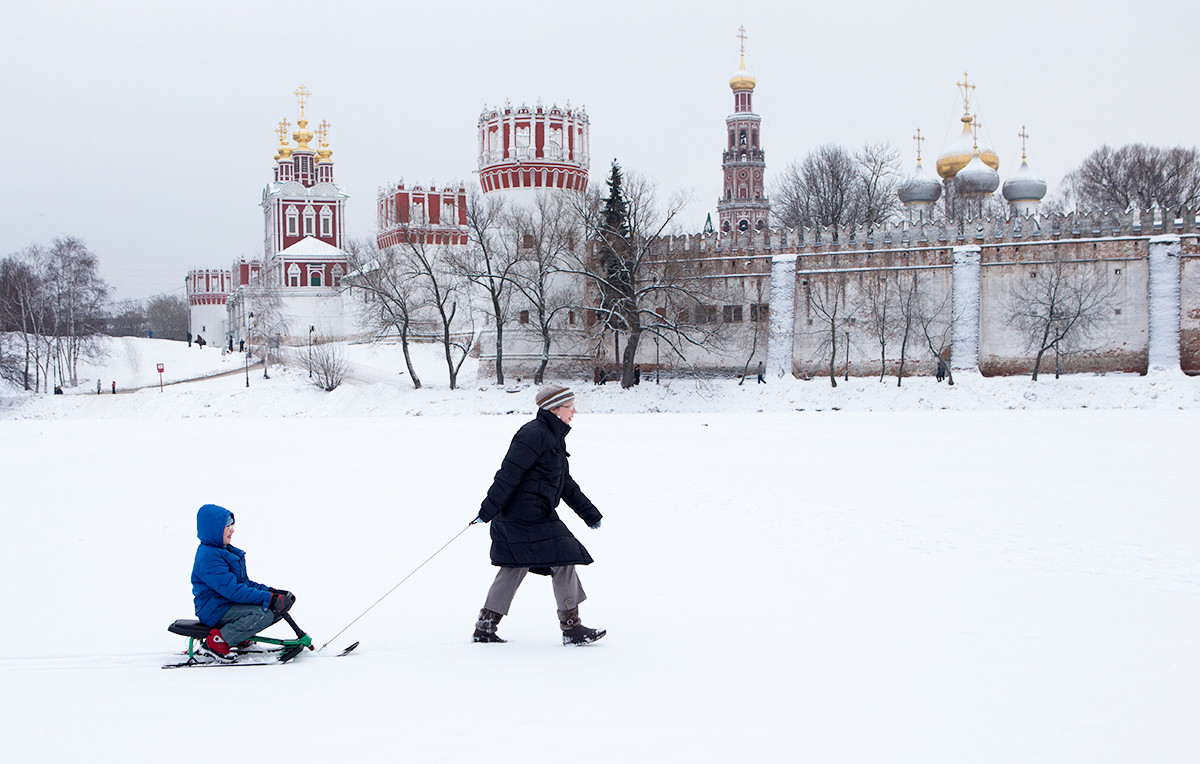
Woman pulls a sled with a child on frozen pond in Moscow, Russia
Fancy a glimpse of the Orthodox Christmas atmosphere as it was in the Russian Empire? Look no further than Novodevichy Convent , a picturesque, snow-covered religious haven with a history stretching back five centuries. Initially used as a fortress for noblewomen, this stunning riverside ensemble is now a functioning monastery and peaceful cloister that boasts four stunning cathedrals, Kremlin-like walls, and a spectacular icon collection. Holy, placid, and serene, the convent is a uniquely antiquate enclave that’s night and day from the bustling modernity that surrounds it.
6. Wallow in the snow
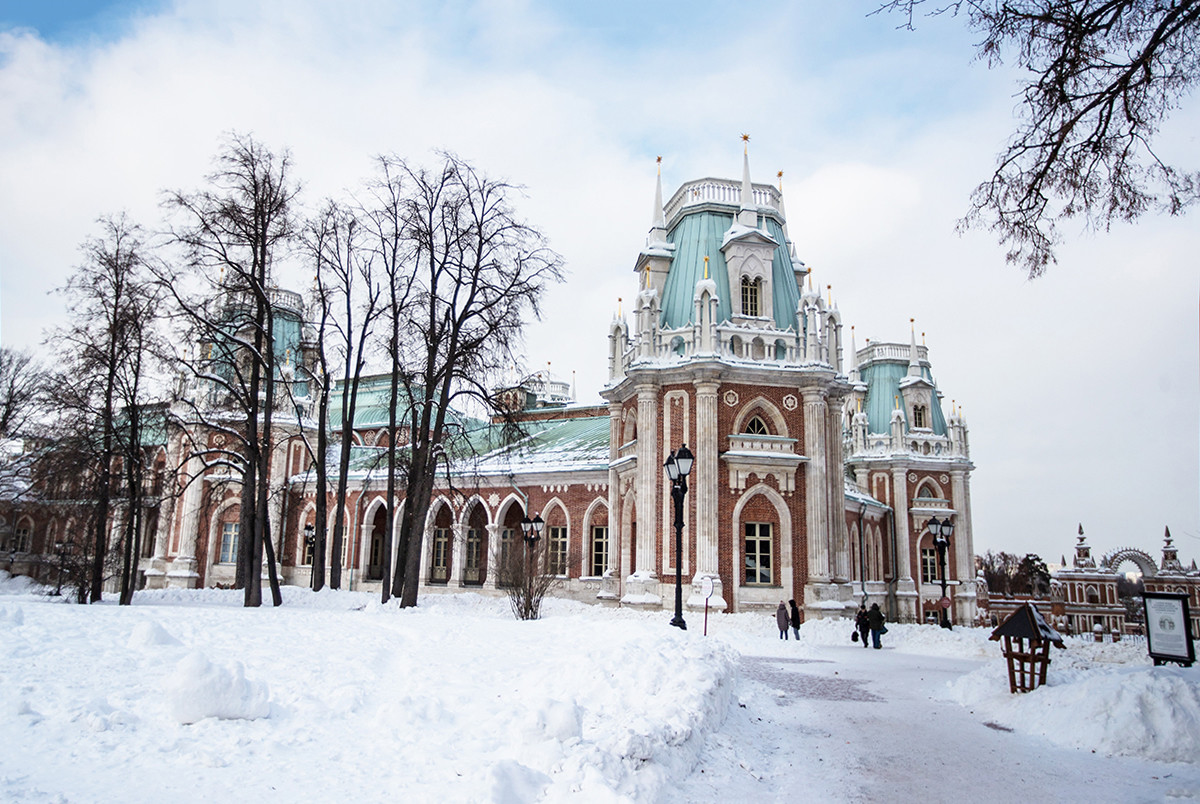
A view of a rebuilt 18th century palace in Moscow's Tsaritsyno Park.
Sometimes, you don’t need anything particularly ambulative to feel at home in a city. In fact, nothing embodies Moscow’s winter wonderland better than a mere stroll in one of its stately parks, sure to be piled high with endless snow dunes throughout the winter.
For a pleasant outing beloved by Muscovites and tourists alike, check out the grandiose Tsaritsyno Park , where nature peacefully co-exists alongside tsarist palatial pomp. The more sizeable Kolomenskoye Park is also worth checking out for a longer excursion that packs in medieval wooden architecture, never-ending rows of trees, and a postcard-ready river view.
However, if you want to really get off the beaten track and experience the winter pristine snow, head further outside the city limits to one of Moscow’s forests – Izmailovsky Park, Timiryazevsky Park, or Elk Island National Park, for example (all accessible by metro).
7. Get festive at the city’s many Christmas markets
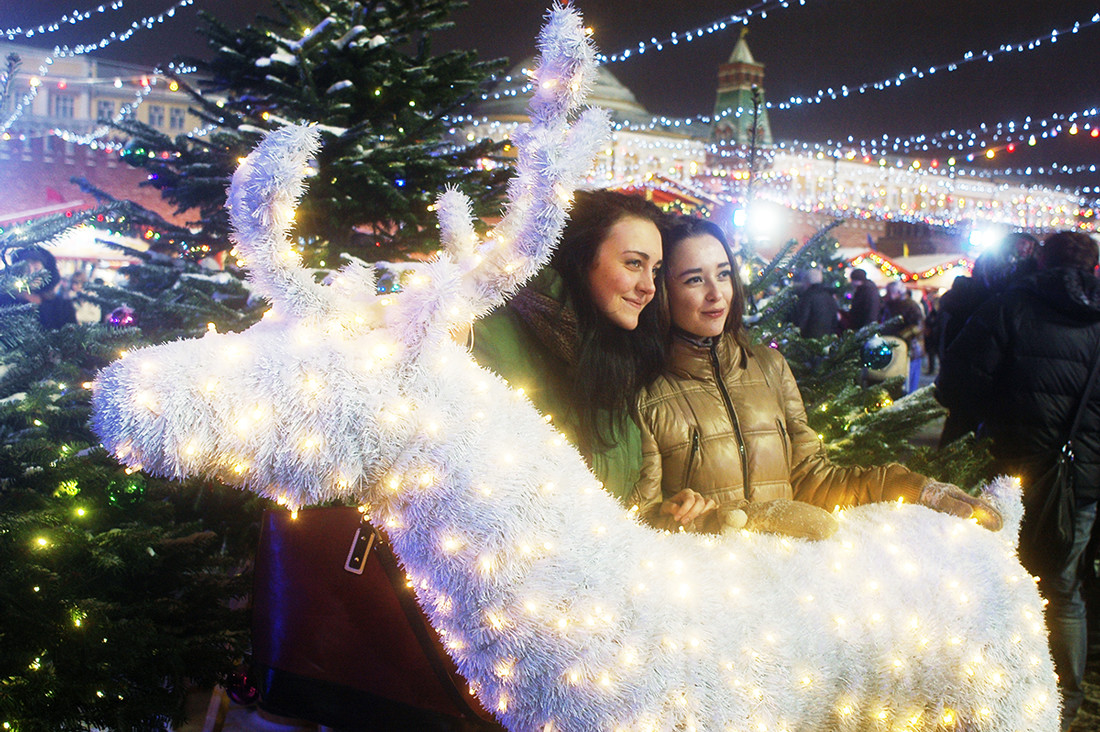
Sip on a mulled wine, soak up the bright lights, haggle over a matryoshka doll with Putin’s face on it. Moscow’s Christmas markets are an absolutely essential tourist experience, with the most popular fair set up right on the Kremlin’s doorsteps on Red Square. Indeed, those quaint stalls in the heart of the city take some beating against the backdrop of St. Basil’s Cathedral and the illuminated GUM shopping center. There are some other cool festive spots throughout the city, though – Gorky Park, for one, will be decked out in lights and international food stalls, while the Izmailovo Kremlin offers an unmissable experience in the world of kitsch souvenir shopping from vodka to pottery, to (sort of) authentic samovars.
If using any of Russia Beyond's content, partly or in full, always provide an active hyperlink to the original material.
to our newsletter!
Get the week's best stories straight to your inbox
- 12 places in Moscow you gotta visit (according to expats)
- 10 surprising facts about Moscow
- Souvenirs, a fake Kremlin, craft food: Your ultimate guide to Izmailovo Market
- 10 places in St. Petersburg that expats say you should visit
- 8 Russian winter wonderlands you need to visit before the Xmas lights go out
This website uses cookies. Click here to find out more.

IMAGES
VIDEO
COMMENTS
With Schubert's Winter Journey: Anatomy of an Obsession, Ian Bostridge proves to be one of the most impressive writers among musical performers, as erudite and vivid as he is entertaining. . . . Ian Bostridge's book is brilliant and unique. After reading it, we may listen differently to this supreme work of art, one that, despite being ...
An exploration of the world's most famous and challenging song cycle, Schubert's Winter Journey (Winterreise), by a leading interpreter of the work, who teases out the themes—literary, historical, psychological—that weave through the twenty-four songs that make up this legendary masterpiece. Completed in the last months of the young Schubert's life, Winterreise has come to be ...
"Schubert's Winter Journey provides a fascinating insight not just into the song cycle and the mindset of its composer but also that of a leading interpreter." — Financial Times (UK) "Winterreise , Bostridge argues, is 'a message in a bottle set afloat in the cultural ocean of 1828' and, with the confidence of a master oarsman ...
Franz Schubert's Winterreise is at the same time one of the most powerful and one of the most enigmatic masterpieces in Western culture. In his new book, Schubert's Winter Journey: Anatomy of an Obsession, Ian Bostridge - one of the work's finest interpreters - focusses on the context, resonance and personal significance of a work which is possibly the greatest landmark in the history of Lieder.
Feb. 18, 2015. When Schubert played "Winterreise," one of the greatest cycles of art songs, or lieder, ever written, for a gathering of his friends, they were puzzled. As one member of his ...
In Schubert's Winter Journey: Anatomy of an Obsession, Ian Bostridge, an English tenor, takes readers through Winterreise, examining each of the 24 songs. Bostridge himself has sung Winterreise for 30 years, and he believes what Schubert accomplished is as worthy of praise and study as works by Shakespeare and Dante.
An exploration of the world's most famous and challenging song cycle, Schubert's Winter Journey (Winterreise), by a leading interpreter of the work, who teases out the themes—literary, historical, psychological—that weave through the twenty-four songs that make up this legendary masterpiece.Completed in the last months of the young Schubert's life, Winterreise has come to be considered ...
Franz Schubert's Winterreise is at the same time one of the most powerful and one of the most enigmatic masterpieces in Western culture. In his new book, Schubert's Winter Journey: Anatomy of an Obsession, Ian Bostridge - one of the work's finest interpreters - focusses on the context, resonance and personal significance of a work which is possibly the greatest landmark in the history of Lieder.
With Schubert's Winter Journey: Anatomy of an Obsession, Ian Bostridge proves to be one of the most impressive writers among musical performers, as erudite and vivid as he is entertaining. . . . Ian Bostridge's book is brilliant and unique. After reading it, we may listen differently to this supreme work of art, one that, despite being tainted ...
"Schubert's Winter Journey provides a fascinating insight not just into the song cycle and the mindset of its composer but also that of a leading interpreter." — Financial Times (UK) "Winterreise , Bostridge argues, is 'a message in a bottle set afloat in the cultural ocean of 1828' and, with the confidence of a master oarsman ...
So Bostridge argues in Schubert's Winter Journey: Anatomy of an Obsession, his new book about Winterreise. In the process he delivers a mini-lecture, explaining that the cult of sensibility and ...
Schubert's winter journey : anatomy of an obsession Bookreader Item Preview ... Bostridge, Ian, author. Publication date 2015 Topics Schubert, Franz, 1797-1828. Winterreise Publisher New York : Alfred A. Knopf Collection printdisabled; internetarchivebooks Contributor Internet Archive
In "Schubert's Winter Journey"— an appropriately small but elegant volume in a starkly white dust jacket — Bostridge reflects on what he's learned after 30 years of studying and performing ...
"An exploration of the world's most famous and challenging song cycle, Schubert's Winter Journey (Winterreise), by a leading interpreter of the work, who teases out the themes--literary, historical, psychological--that weave through the twenty-four songs that make up this legendary masterpiece. Completed in the last months of the young Schubert's life, Winterreise has come to be considered the ...
Ian Bostridge. An exploration of the world's most famous and challenging song cycle Schubert's Winter Journey ( Winterreise) by a leading interpreter of the work, who teases out the themes—literary, historical, psychological—that weave through the twenty-four songs that make up this legendary masterpiece. Buy on Amazon View on Worldcat ...
Schubert's Winter Journey: Anatomy of an Obsession [BOSTRIDGE Ian] on Amazon.com. *FREE* shipping on qualifying offers. Schubert's Winter Journey: Anatomy of an Obsession ... Schubert's Winter Journey: Anatomy of an Obsession. Skip to main content.us. Delivering to Lebanon 66952 Update location Books. Select the department you want to search in ...
The narrator of "Winterreise" ("Winter Journey"), Franz Schubert's 1827 song cycle on Wilhelm Müller's poems, has had to leave home, walking through an increasingly frozen landscape ...
[email protected] Schubert's Winter Journey: Anatomy of an Obsession, by Ian Bostridge, Knopf, 528 pages, 030796163X, 978-0307961631 (2015) Reviewed by Benjamin M. Korstvedt Published in the Washington Independent Review of Books in May, 2015 In Schubert's Winter Journey: Anatomy of an Obsession Ian Bostridge, a leading British ...
We will also shortly present the stops we had en route and give you some suggestions on what to see there, as an idea, while you start planning your journey. 1. Planning your Trans-Siberian Railway trip. 2. Best time to travel the Trans-Siberian Railway. Trans-Siberian in summer. Trans-Siberian in autumn.
Arctic Rail Explorer - Quest for Northern Lights. Golden Eagle private train | Group railway journey | Set departures. 12 days From(USD) $13,795 Discover. Our team offers over 18 years of experience travelling and planning travel in Russia. Delivering outstanding travel experiences in Russia's capitals and in some of the most stunning ...
And, finally, you could also make a quick visit to the Moscow Kremlin Museums and admire artifacts from various Russian tsarist eras: carriages, thrones, crowns and the most incredible armory and ...
1. Get your skates on. People at the opening of the Street Rink outdoor skating rink in Gorky Park, Moscow. Evgeny Biyatov/Sputnik. Young or old, sporty or couch potato, it doesn't matter ...
Bostridge's love for Schubert's Winterreise and his passion for music and for learning all are on full display in his book, "Schubert's Winter's Journey: Anatomy of an Obsession." The obsession in question is shared by Muller and Schubert's nameless wanderer in the cycle, by Bostridge himself, and by the reader of the book and listener to the ...